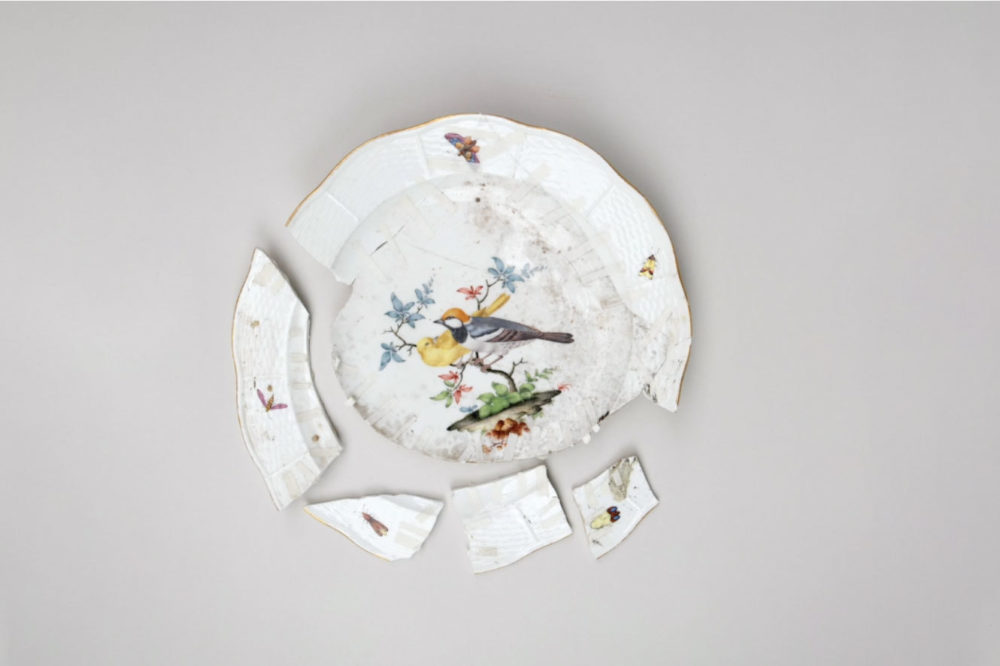letters home, installation view, 2024
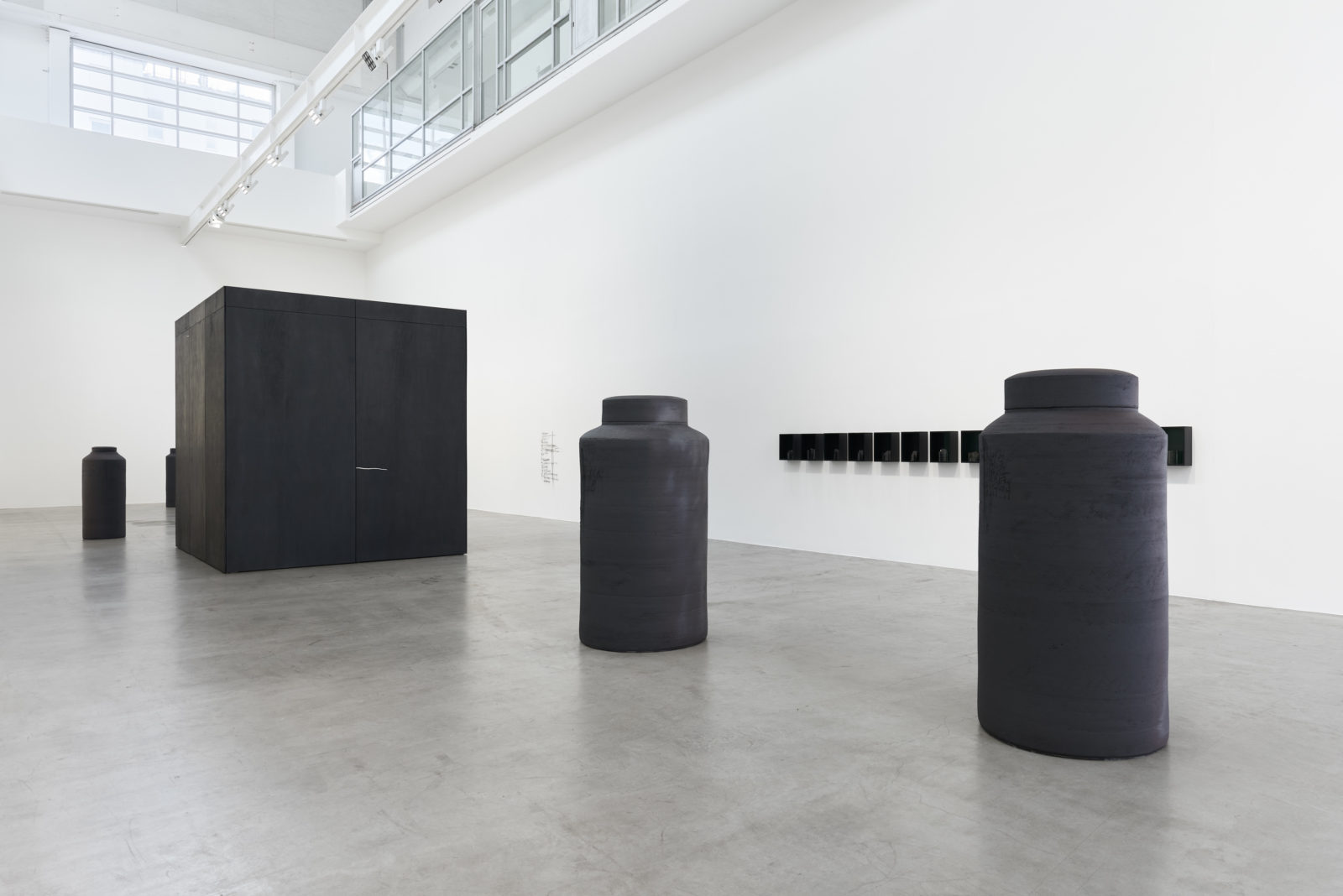
letters home, installation view, 2024
letters home
Galerie Max Hetzler, Berlin
14 June–10 August 2024
letters home is a solo exhibition of works by Edmund de Waal at Galerie Max Hetzler, Potsdamer Straße 77-87, Berlin. In addition to black, white and oak vitrines made this year, the exhibition includes both the largest free-standing clay vessels the artist has ever created, and a large-scale pavilion titled there are still songs to sing beyond mankind, 2024. Despite their differences in size and material, all the works are ultimately vessels whose interiors only seem to become more intimate as their dimensions increase.
Individual words or phrases from poems by Denise Riley (b. 1948), Paul Celan (1920–1970) and Rainer Maria Rilke (1875–1926) are interwoven in the titles or surfaces of these works by de Waal. Here, the focus is not on analysing the texts, but rather on their emotional heft. A further reference to language can be found in the forms of the vitrines, which seem reminiscent of pages from a book. The pavilion, also referred to as a kind of 'teahouse’ by de Waal, draws on the artist's memories of stays in Japan and his studies of sadō, the Japanese tea ceremony.
In dialogue not only with one another, but with history, literature and their surrounding space, de Waal’s works provide a place for pause, in his words, ‘letters home – my attempt to feel both the breath of separation and the pulse of connection’.
letters home, installation view, 2024
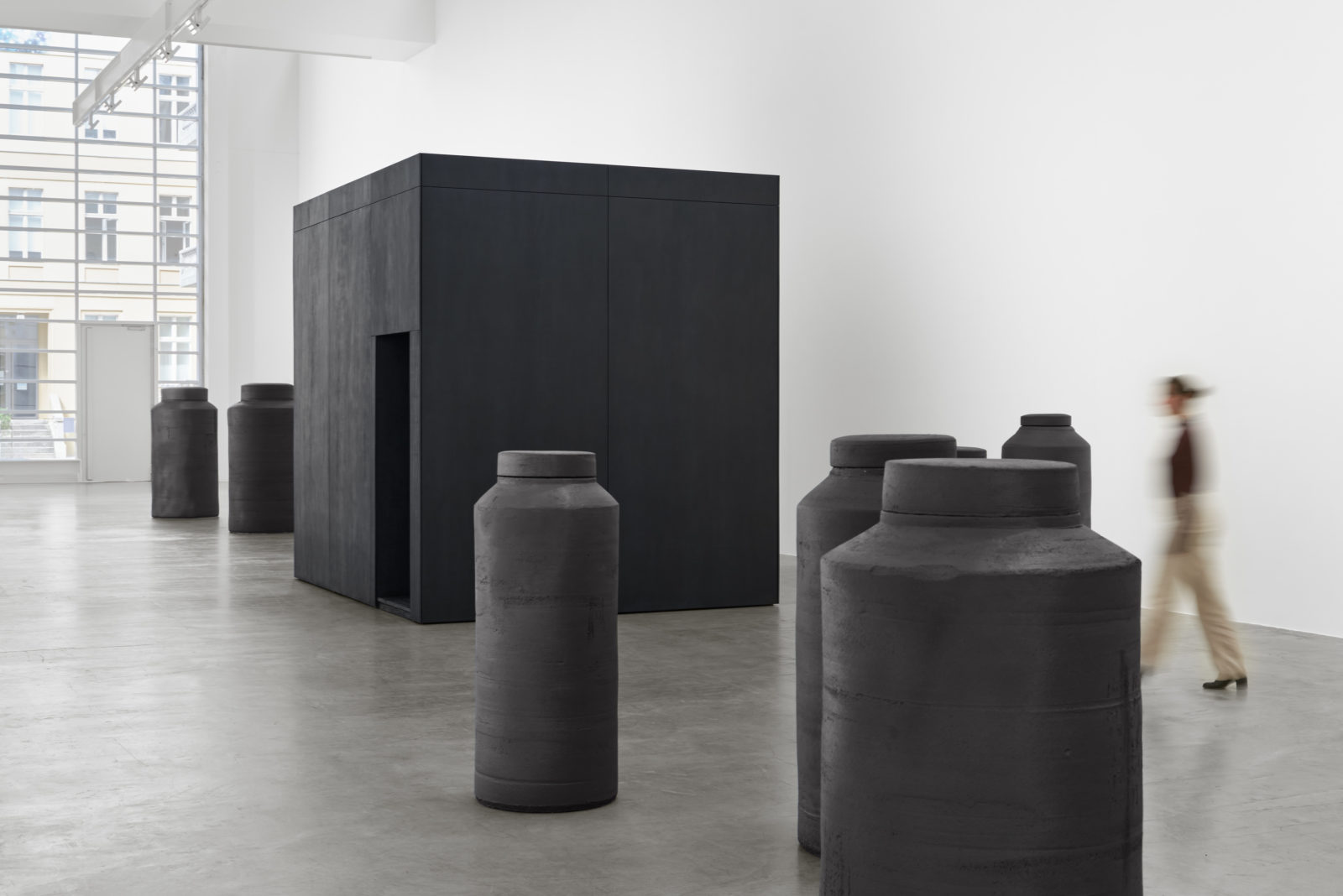
letters home, installation view, 2024
letters home
Galerie Max Hetzler, Berlin
14 June–10 August 2024
letters home is a solo exhibition of works by Edmund de Waal at Galerie Max Hetzler, Potsdamer Straße 77-87, Berlin. In addition to black, white and oak vitrines made this year, the exhibition includes both the largest free-standing clay vessels the artist has ever created, and a large-scale pavilion titled there are still songs to sing beyond mankind, 2024. Despite their differences in size and material, all the works are ultimately vessels whose interiors only seem to become more intimate as their dimensions increase.
Individual words or phrases from poems by Denise Riley (b. 1948), Paul Celan (1920–1970) and Rainer Maria Rilke (1875–1926) are interwoven in the titles or surfaces of these works by de Waal. Here, the focus is not on analysing the texts, but rather on their emotional heft. A further reference to language can be found in the forms of the vitrines, which seem reminiscent of pages from a book. The pavilion, also referred to as a kind of 'teahouse’ by de Waal, draws on the artist's memories of stays in Japan and his studies of sadō, the Japanese tea ceremony.
In dialogue not only with one another, but with history, literature and their surrounding space, de Waal’s works provide a place for pause, in his words, ‘letters home – my attempt to feel both the breath of separation and the pulse of connection’.
elegie, I (detail), 2023
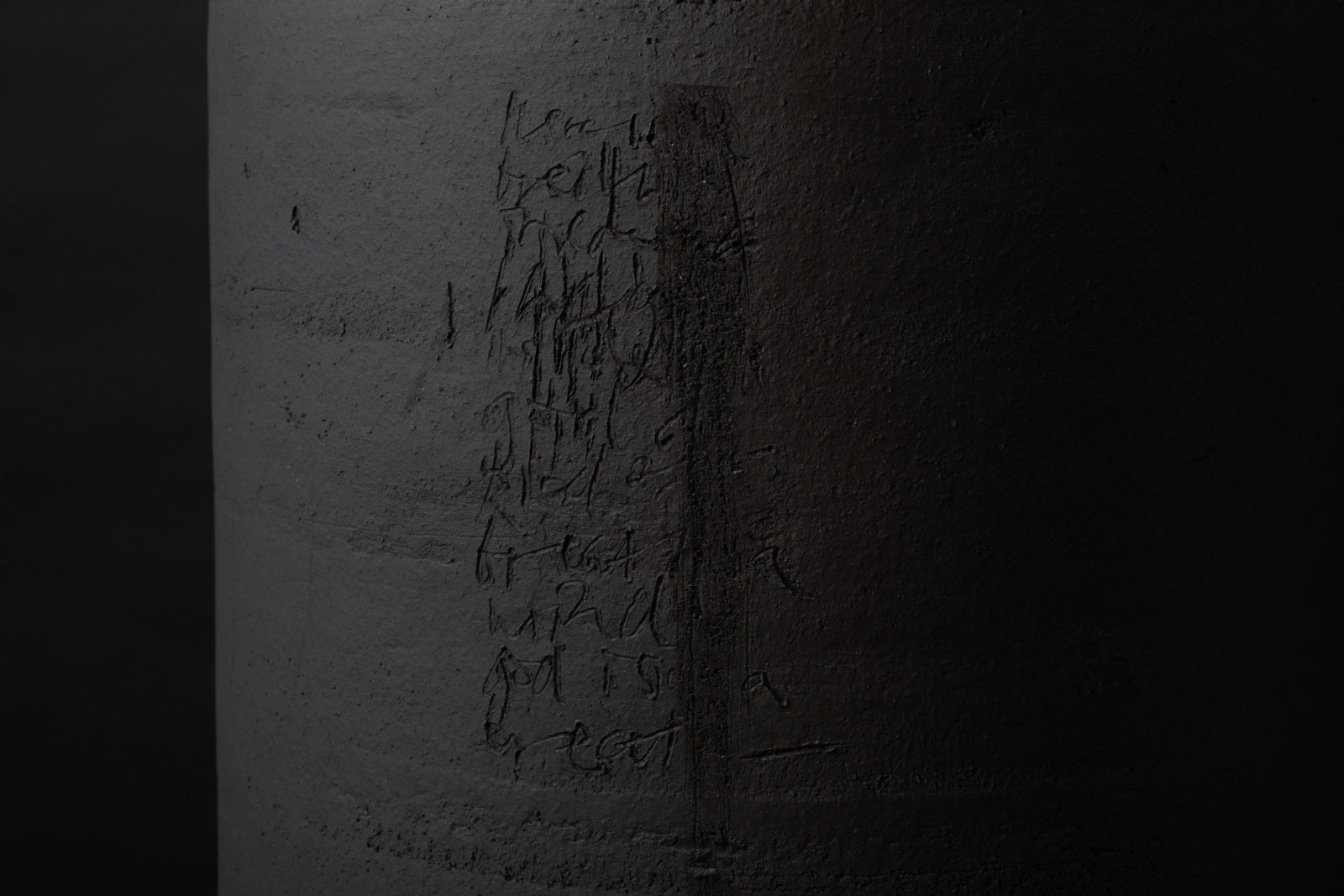
elegie, I (detail), 2023
Stoneware vessel with inscription146 × 59.5 cm
letters home
Galerie Max Hetzler, Berlin
14 June–10 August 2024
letters home is a solo exhibition of works by Edmund de Waal at Galerie Max Hetzler, Potsdamer Straße 77-87, Berlin. In addition to black, white and oak vitrines made this year, the exhibition includes both the largest free-standing clay vessels the artist has ever created, and a large-scale pavilion titled there are still songs to sing beyond mankind, 2024. Despite their differences in size and material, all the works are ultimately vessels whose interiors only seem to become more intimate as their dimensions increase.
Individual words or phrases from poems by Denise Riley (b. 1948), Paul Celan (1920–1970) and Rainer Maria Rilke (1875–1926) are interwoven in the titles or surfaces of these works by de Waal. Here, the focus is not on analysing the texts, but rather on their emotional heft. A further reference to language can be found in the forms of the vitrines, which seem reminiscent of pages from a book. The pavilion, also referred to as a kind of 'teahouse’ by de Waal, draws on the artist's memories of stays in Japan and his studies of sadō, the Japanese tea ceremony.
In dialogue not only with one another, but with history, literature and their surrounding space, de Waal’s works provide a place for pause, in his words, ‘letters home – my attempt to feel both the breath of separation and the pulse of connection’.
letters home, installation view, 2024
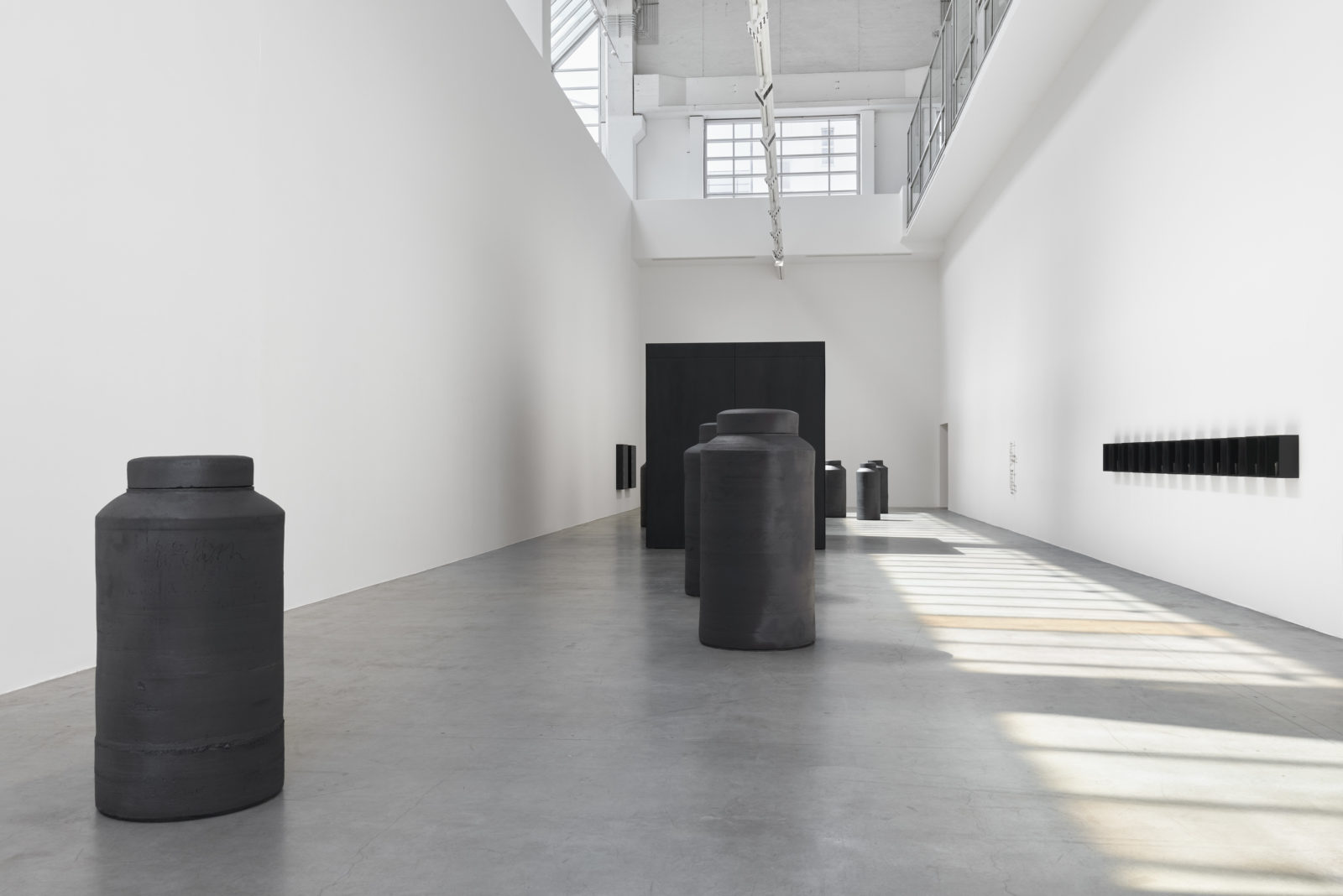
letters home, installation view, 2024
letters home
Galerie Max Hetzler, Berlin
14 June–10 August 2024
letters home is a solo exhibition of works by Edmund de Waal at Galerie Max Hetzler, Potsdamer Straße 77-87, Berlin. In addition to black, white and oak vitrines made this year, the exhibition includes both the largest free-standing clay vessels the artist has ever created, and a large-scale pavilion titled there are still songs to sing beyond mankind, 2024. Despite their differences in size and material, all the works are ultimately vessels whose interiors only seem to become more intimate as their dimensions increase.
Individual words or phrases from poems by Denise Riley (b. 1948), Paul Celan (1920–1970) and Rainer Maria Rilke (1875–1926) are interwoven in the titles or surfaces of these works by de Waal. Here, the focus is not on analysing the texts, but rather on their emotional heft. A further reference to language can be found in the forms of the vitrines, which seem reminiscent of pages from a book. The pavilion, also referred to as a kind of 'teahouse’ by de Waal, draws on the artist's memories of stays in Japan and his studies of sadō, the Japanese tea ceremony.
In dialogue not only with one another, but with history, literature and their surrounding space, de Waal’s works provide a place for pause, in his words, ‘letters home – my attempt to feel both the breath of separation and the pulse of connection’.
letters home, I, 2024; letters home, III, 2024; elegie, II, 2023
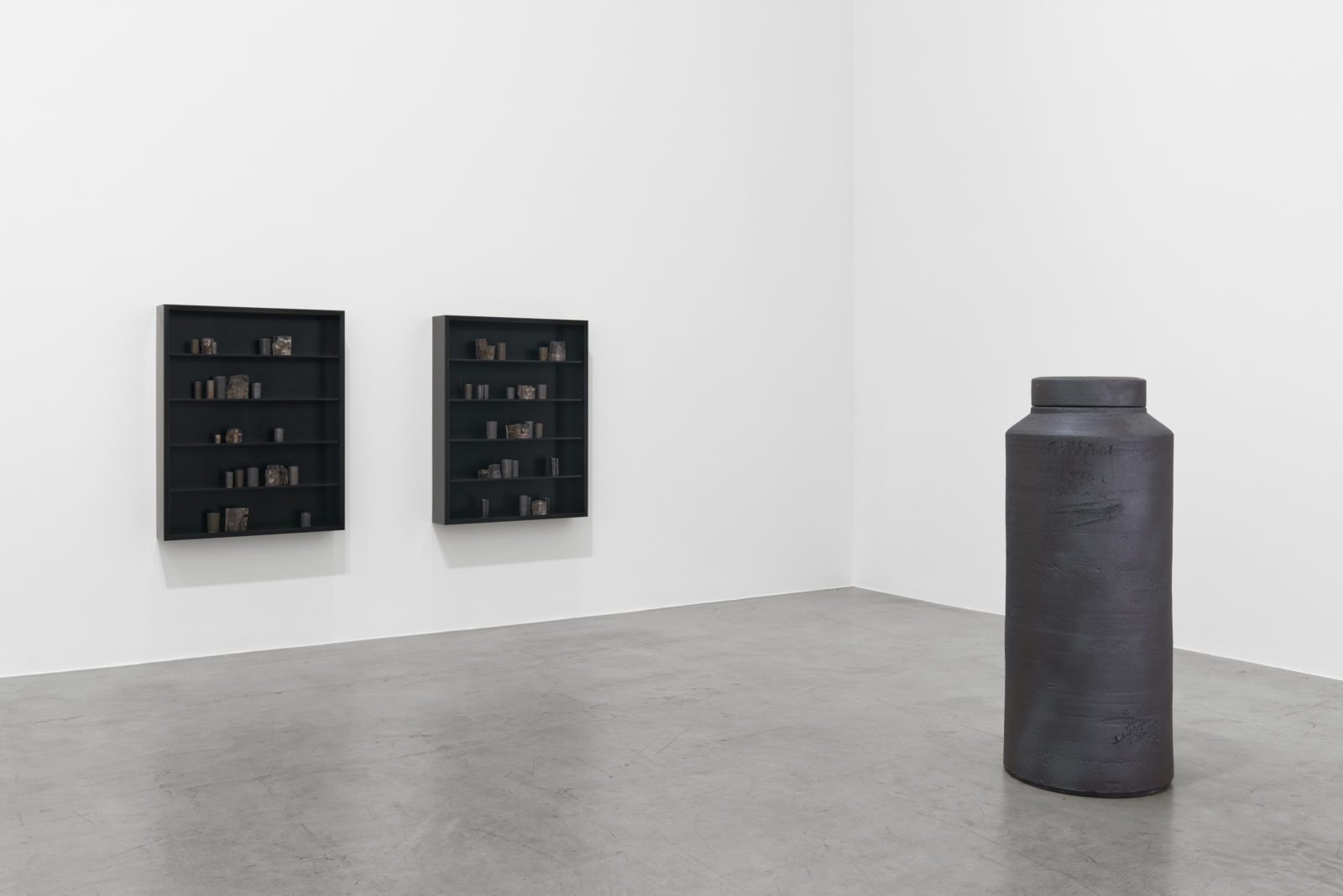
letters home, I, 2024; letters home, III, 2024; elegie, II, 2023
letters home
Galerie Max Hetzler, Berlin
14 June–10 August 2024
letters home is a solo exhibition of works by Edmund de Waal at Galerie Max Hetzler, Potsdamer Straße 77-87, Berlin. In addition to black, white and oak vitrines made this year, the exhibition includes both the largest free-standing clay vessels the artist has ever created, and a large-scale pavilion titled there are still songs to sing beyond mankind, 2024. Despite their differences in size and material, all the works are ultimately vessels whose interiors only seem to become more intimate as their dimensions increase.
Individual words or phrases from poems by Denise Riley (b. 1948), Paul Celan (1920–1970) and Rainer Maria Rilke (1875–1926) are interwoven in the titles or surfaces of these works by de Waal. Here, the focus is not on analysing the texts, but rather on their emotional heft. A further reference to language can be found in the forms of the vitrines, which seem reminiscent of pages from a book. The pavilion, also referred to as a kind of 'teahouse’ by de Waal, draws on the artist's memories of stays in Japan and his studies of sadō, the Japanese tea ceremony.
In dialogue not only with one another, but with history, literature and their surrounding space, de Waal’s works provide a place for pause, in his words, ‘letters home – my attempt to feel both the breath of separation and the pulse of connection’.
elegie, II, (detail) 2023
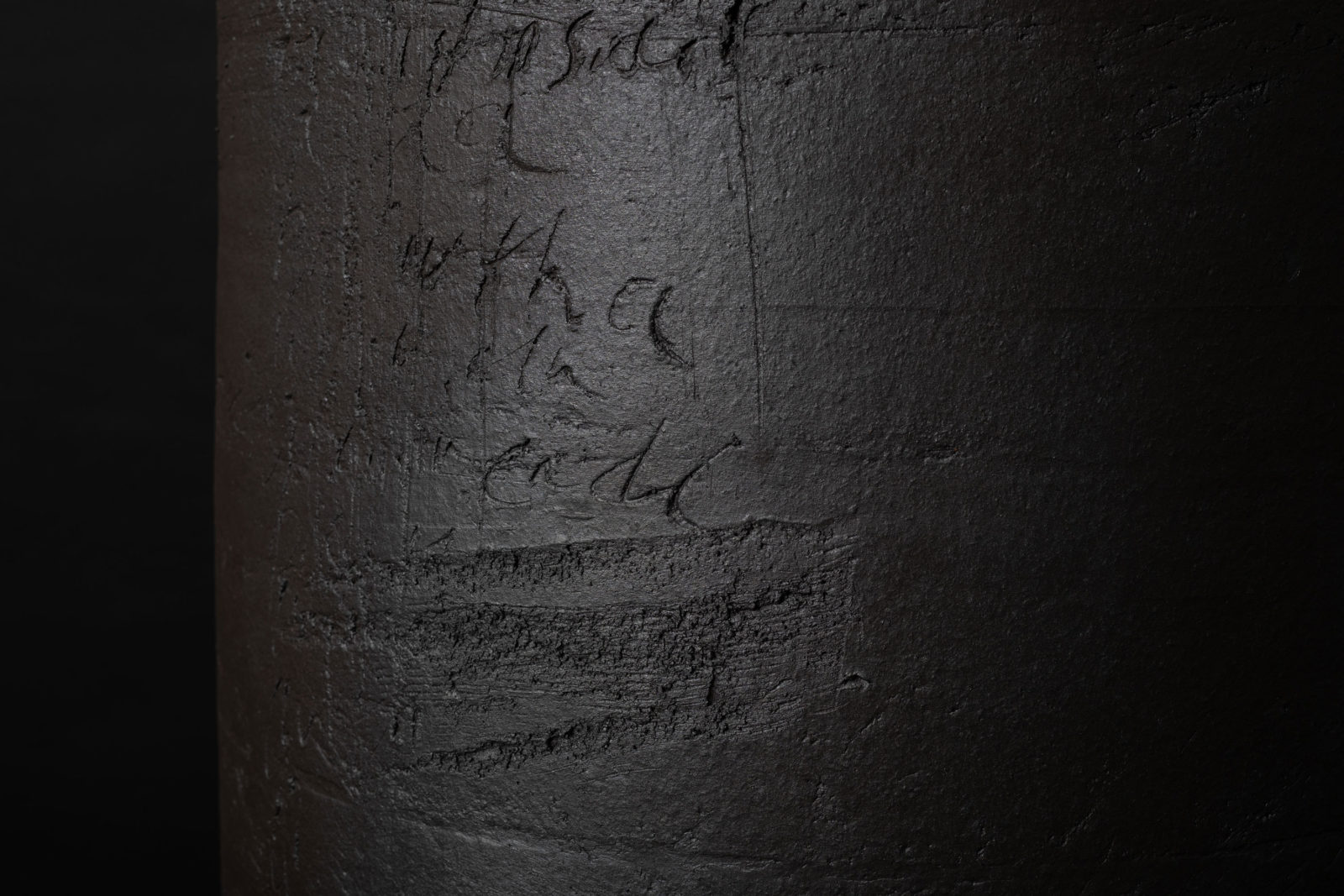
elegie, II, (detail) 2023
letters home
Galerie Max Hetzler, Berlin
14 June–10 August 2024
letters home is a solo exhibition of works by Edmund de Waal at Galerie Max Hetzler, Potsdamer Straße 77-87, Berlin. In addition to black, white and oak vitrines made this year, the exhibition includes both the largest free-standing clay vessels the artist has ever created, and a large-scale pavilion titled there are still songs to sing beyond mankind, 2024. Despite their differences in size and material, all the works are ultimately vessels whose interiors only seem to become more intimate as their dimensions increase.
Individual words or phrases from poems by Denise Riley (b. 1948), Paul Celan (1920–1970) and Rainer Maria Rilke (1875–1926) are interwoven in the titles or surfaces of these works by de Waal. Here, the focus is not on analysing the texts, but rather on their emotional heft. A further reference to language can be found in the forms of the vitrines, which seem reminiscent of pages from a book. The pavilion, also referred to as a kind of 'teahouse’ by de Waal, draws on the artist's memories of stays in Japan and his studies of sadō, the Japanese tea ceremony.
In dialogue not only with one another, but with history, literature and their surrounding space, de Waal’s works provide a place for pause, in his words, ‘letters home – my attempt to feel both the breath of separation and the pulse of connection’.
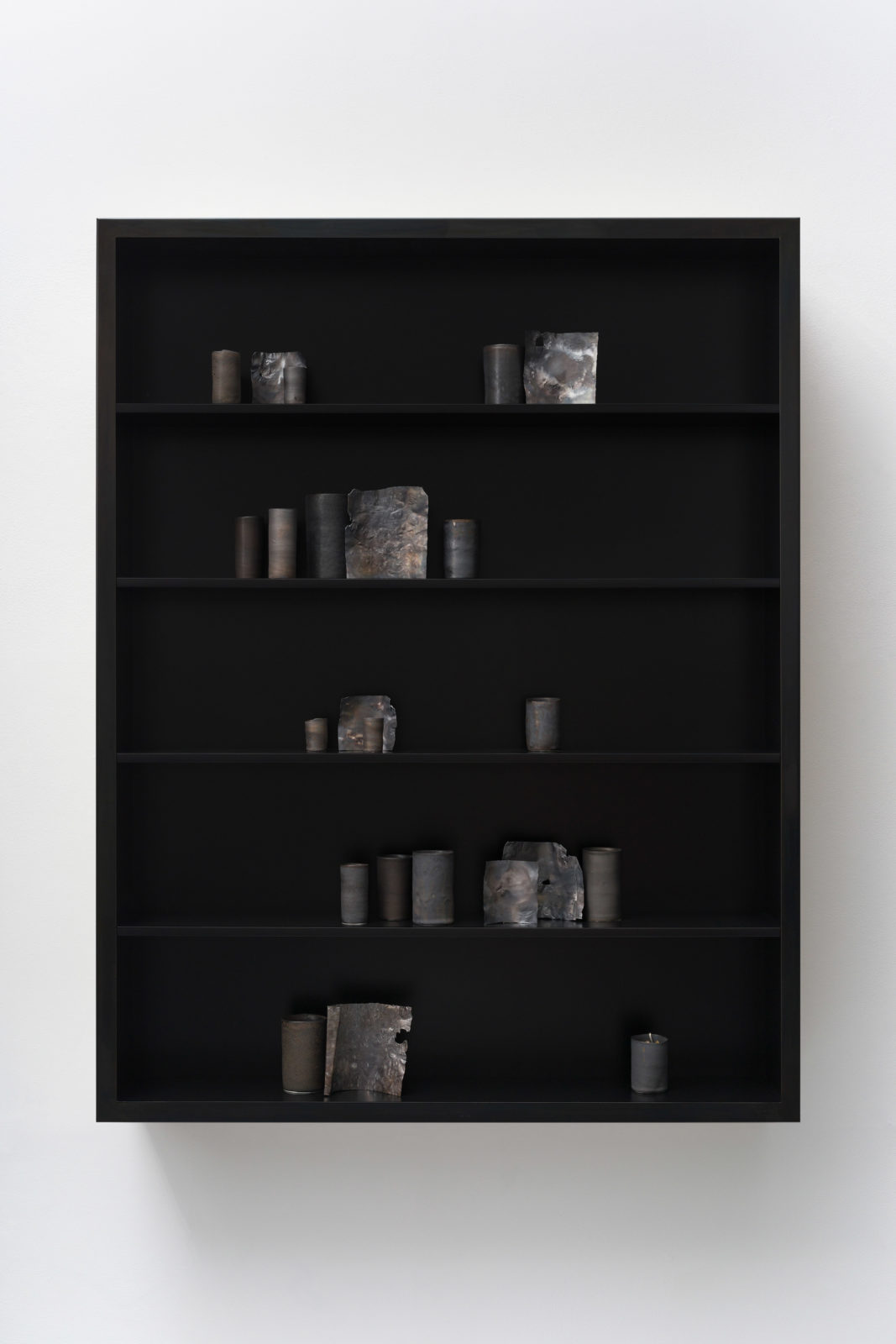
letters home, I2024
Porcelain, silver, lead, steel, wood and glass
122 × 95 × 19 cm
letters home
Galerie Max Hetzler, Berlin
14 June–10 August 2024
letters home is a solo exhibition of works by Edmund de Waal at Galerie Max Hetzler, Potsdamer Straße 77-87, Berlin. In addition to black, white and oak vitrines made this year, the exhibition includes both the largest free-standing clay vessels the artist has ever created, and a large-scale pavilion titled there are still songs to sing beyond mankind, 2024. Despite their differences in size and material, all the works are ultimately vessels whose interiors only seem to become more intimate as their dimensions increase.
Individual words or phrases from poems by Denise Riley (b. 1948), Paul Celan (1920–1970) and Rainer Maria Rilke (1875–1926) are interwoven in the titles or surfaces of these works by de Waal. Here, the focus is not on analysing the texts, but rather on their emotional heft. A further reference to language can be found in the forms of the vitrines, which seem reminiscent of pages from a book. The pavilion, also referred to as a kind of 'teahouse’ by de Waal, draws on the artist's memories of stays in Japan and his studies of sadō, the Japanese tea ceremony.
In dialogue not only with one another, but with history, literature and their surrounding space, de Waal’s works provide a place for pause, in his words, ‘letters home – my attempt to feel both the breath of separation and the pulse of connection’.
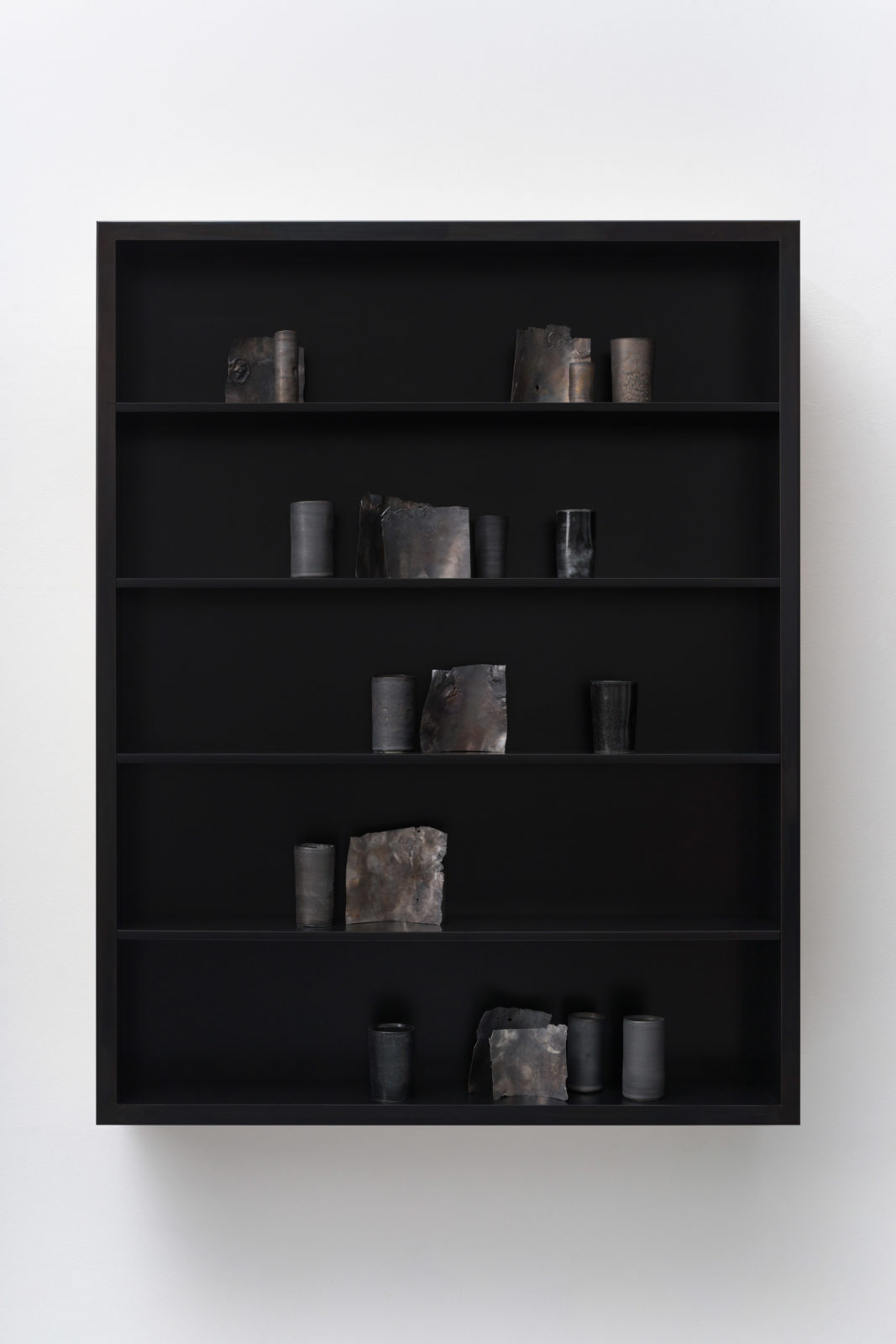
letters home, II2024
Porcelain, silver, steel, wood and glass
122 × 95 × 19 cm
letters home
Galerie Max Hetzler, Berlin
14 June–10 August 2024
letters home is a solo exhibition of works by Edmund de Waal at Galerie Max Hetzler, Potsdamer Straße 77-87, Berlin. In addition to black, white and oak vitrines made this year, the exhibition includes both the largest free-standing clay vessels the artist has ever created, and a large-scale pavilion titled there are still songs to sing beyond mankind, 2024. Despite their differences in size and material, all the works are ultimately vessels whose interiors only seem to become more intimate as their dimensions increase.
Individual words or phrases from poems by Denise Riley (b. 1948), Paul Celan (1920–1970) and Rainer Maria Rilke (1875–1926) are interwoven in the titles or surfaces of these works by de Waal. Here, the focus is not on analysing the texts, but rather on their emotional heft. A further reference to language can be found in the forms of the vitrines, which seem reminiscent of pages from a book. The pavilion, also referred to as a kind of 'teahouse’ by de Waal, draws on the artist's memories of stays in Japan and his studies of sadō, the Japanese tea ceremony.
In dialogue not only with one another, but with history, literature and their surrounding space, de Waal’s works provide a place for pause, in his words, ‘letters home – my attempt to feel both the breath of separation and the pulse of connection’.
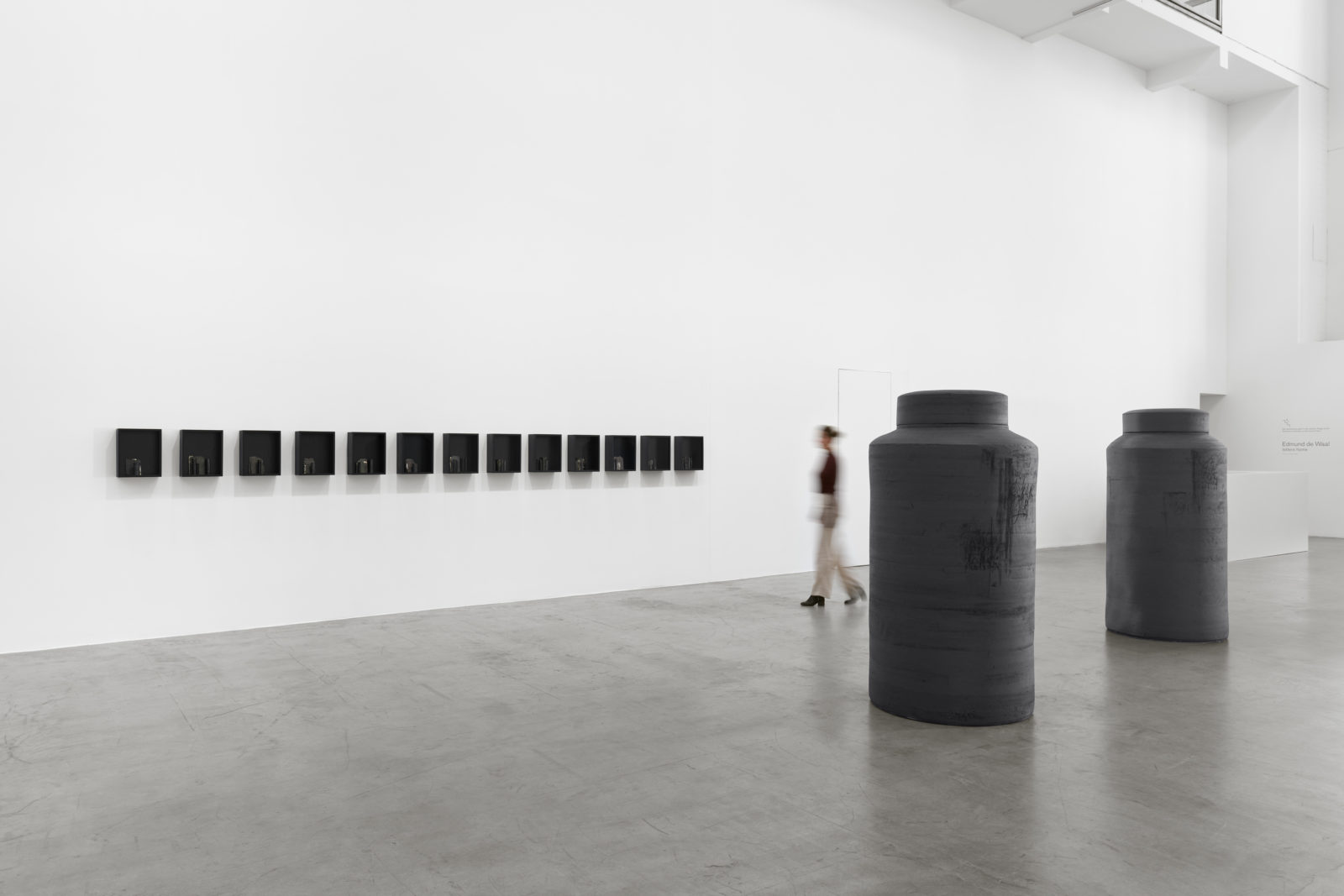
a part song, I–XIII; elegie, IX; elegie, VIII2024
letters home
Galerie Max Hetzler, Berlin
14 June–10 August 2024
letters home is a solo exhibition of works by Edmund de Waal at Galerie Max Hetzler, Potsdamer Straße 77-87, Berlin. In addition to black, white and oak vitrines made this year, the exhibition includes both the largest free-standing clay vessels the artist has ever created, and a large-scale pavilion titled there are still songs to sing beyond mankind, 2024. Despite their differences in size and material, all the works are ultimately vessels whose interiors only seem to become more intimate as their dimensions increase.
Individual words or phrases from poems by Denise Riley (b. 1948), Paul Celan (1920–1970) and Rainer Maria Rilke (1875–1926) are interwoven in the titles or surfaces of these works by de Waal. Here, the focus is not on analysing the texts, but rather on their emotional heft. A further reference to language can be found in the forms of the vitrines, which seem reminiscent of pages from a book. The pavilion, also referred to as a kind of 'teahouse’ by de Waal, draws on the artist's memories of stays in Japan and his studies of sadō, the Japanese tea ceremony.
In dialogue not only with one another, but with history, literature and their surrounding space, de Waal’s works provide a place for pause, in his words, ‘letters home – my attempt to feel both the breath of separation and the pulse of connection’.
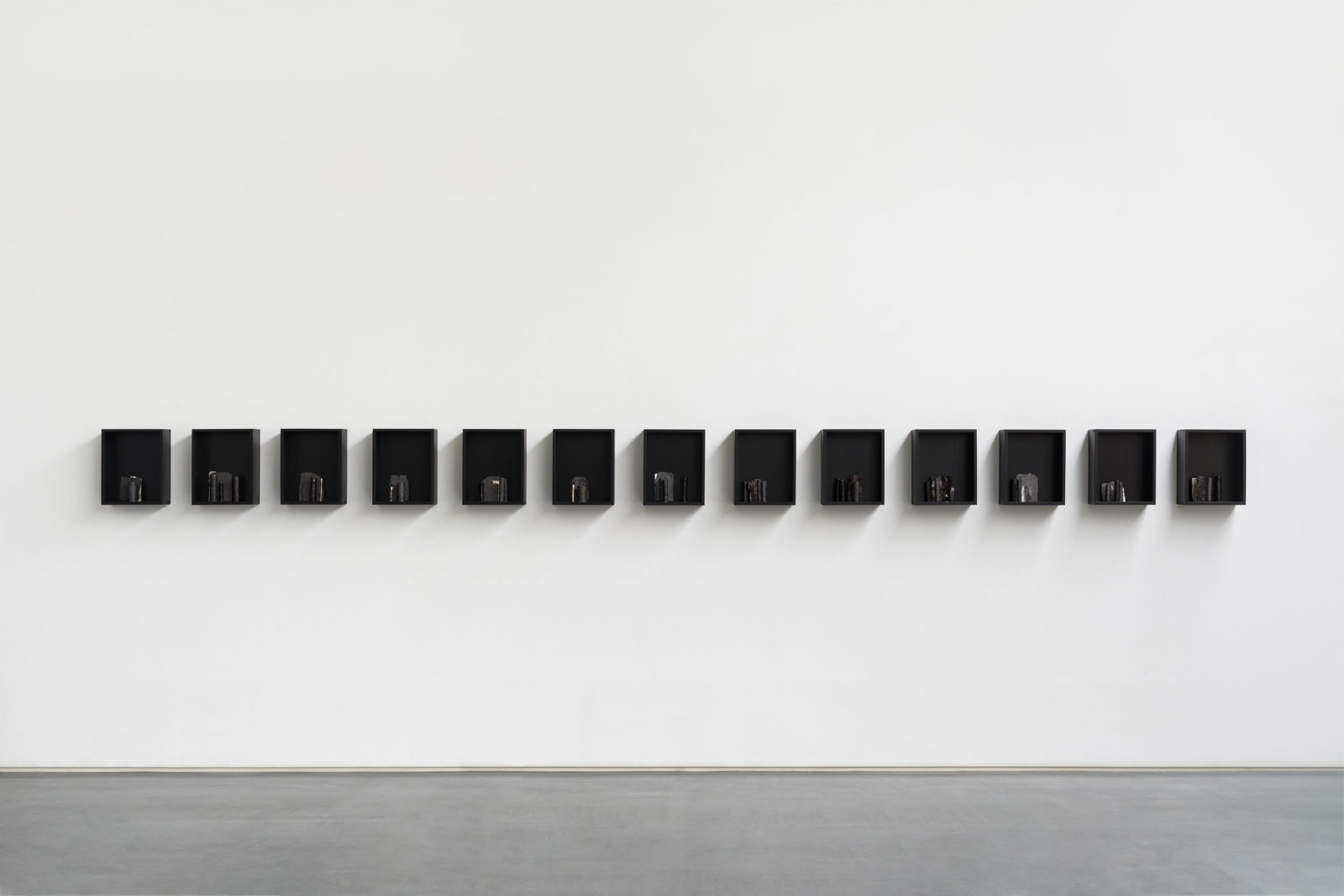
a part song, I–XIII2024
Porcelain, silver, oak and glass
Each vitrine: 37 × 30 × 15 cm
letters home
Galerie Max Hetzler, Berlin
14 June–10 August 2024
letters home is a solo exhibition of works by Edmund de Waal at Galerie Max Hetzler, Potsdamer Straße 77-87, Berlin. In addition to black, white and oak vitrines made this year, the exhibition includes both the largest free-standing clay vessels the artist has ever created, and a large-scale pavilion titled there are still songs to sing beyond mankind, 2024. Despite their differences in size and material, all the works are ultimately vessels whose interiors only seem to become more intimate as their dimensions increase.
Individual words or phrases from poems by Denise Riley (b. 1948), Paul Celan (1920–1970) and Rainer Maria Rilke (1875–1926) are interwoven in the titles or surfaces of these works by de Waal. Here, the focus is not on analysing the texts, but rather on their emotional heft. A further reference to language can be found in the forms of the vitrines, which seem reminiscent of pages from a book. The pavilion, also referred to as a kind of 'teahouse’ by de Waal, draws on the artist's memories of stays in Japan and his studies of sadō, the Japanese tea ceremony.
In dialogue not only with one another, but with history, literature and their surrounding space, de Waal’s works provide a place for pause, in his words, ‘letters home – my attempt to feel both the breath of separation and the pulse of connection’.
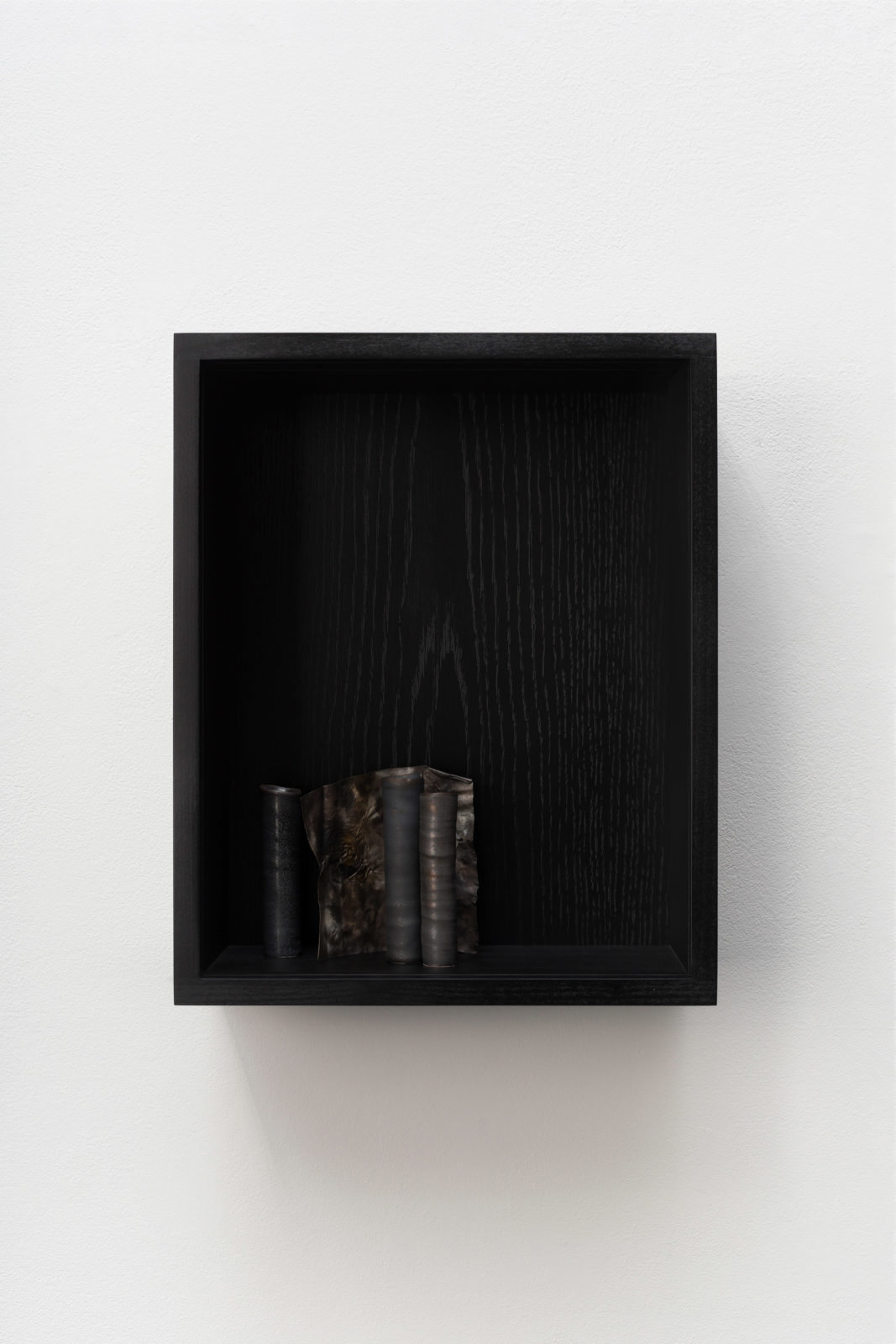
a part song, VIII2024
Porcelain, silver, oak and glass
37 × 30 × 15 cm
letters home
Galerie Max Hetzler, Berlin
14 June–10 August 2024
letters home is a solo exhibition of works by Edmund de Waal at Galerie Max Hetzler, Potsdamer Straße 77-87, Berlin. In addition to black, white and oak vitrines made this year, the exhibition includes both the largest free-standing clay vessels the artist has ever created, and a large-scale pavilion titled there are still songs to sing beyond mankind, 2024. Despite their differences in size and material, all the works are ultimately vessels whose interiors only seem to become more intimate as their dimensions increase.
Individual words or phrases from poems by Denise Riley (b. 1948), Paul Celan (1920–1970) and Rainer Maria Rilke (1875–1926) are interwoven in the titles or surfaces of these works by de Waal. Here, the focus is not on analysing the texts, but rather on their emotional heft. A further reference to language can be found in the forms of the vitrines, which seem reminiscent of pages from a book. The pavilion, also referred to as a kind of 'teahouse’ by de Waal, draws on the artist's memories of stays in Japan and his studies of sadō, the Japanese tea ceremony.
In dialogue not only with one another, but with history, literature and their surrounding space, de Waal’s works provide a place for pause, in his words, ‘letters home – my attempt to feel both the breath of separation and the pulse of connection’.
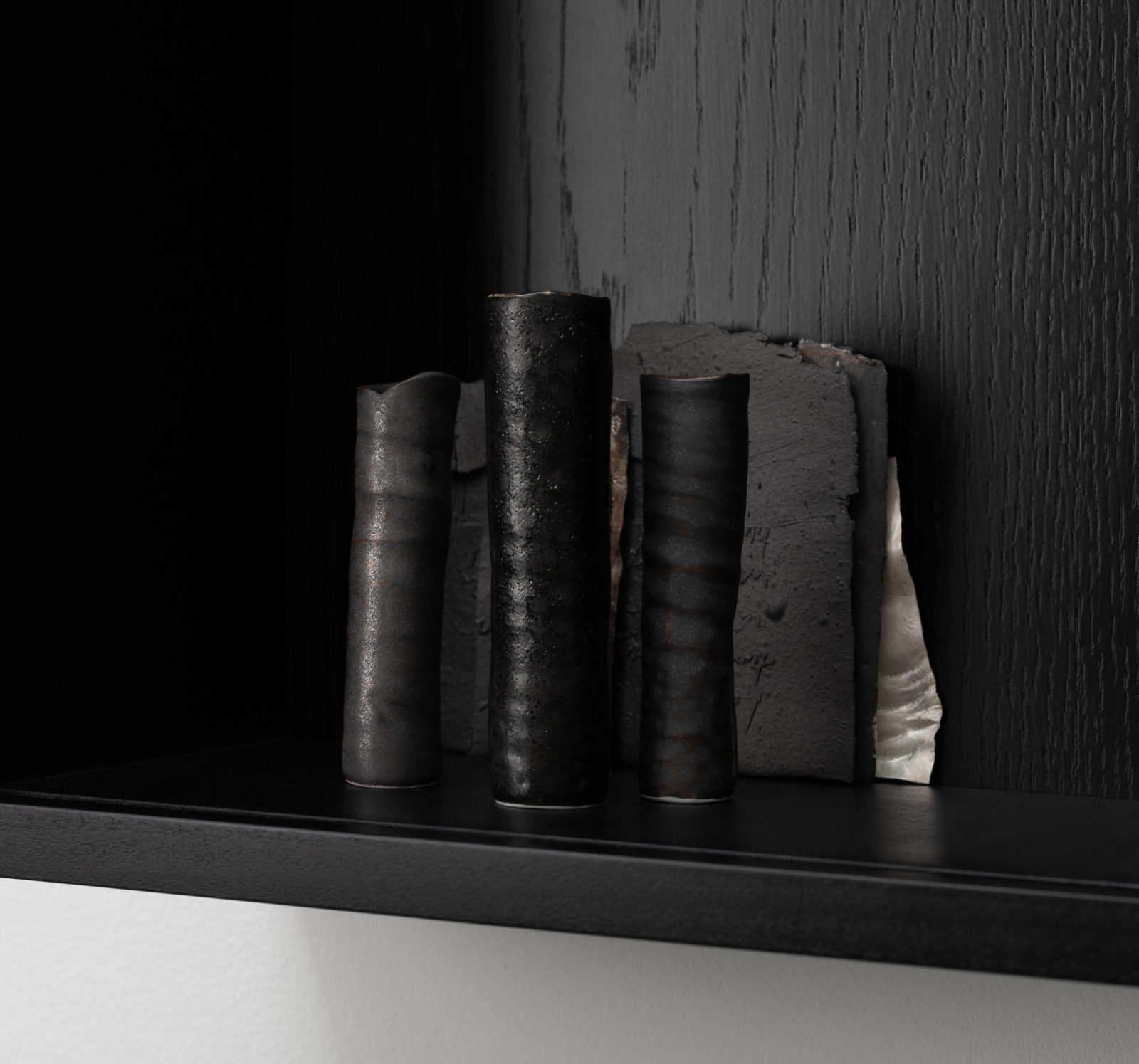
a part song, XII (detail)2024
Porcelain, silver, oak and glass
37 × 30 × 15 cm
letters home
Galerie Max Hetzler, Berlin
14 June–10 August 2024
letters home is a solo exhibition of works by Edmund de Waal at Galerie Max Hetzler, Potsdamer Straße 77-87, Berlin. In addition to black, white and oak vitrines made this year, the exhibition includes both the largest free-standing clay vessels the artist has ever created, and a large-scale pavilion titled there are still songs to sing beyond mankind, 2024. Despite their differences in size and material, all the works are ultimately vessels whose interiors only seem to become more intimate as their dimensions increase.
Individual words or phrases from poems by Denise Riley (b. 1948), Paul Celan (1920–1970) and Rainer Maria Rilke (1875–1926) are interwoven in the titles or surfaces of these works by de Waal. Here, the focus is not on analysing the texts, but rather on their emotional heft. A further reference to language can be found in the forms of the vitrines, which seem reminiscent of pages from a book. The pavilion, also referred to as a kind of 'teahouse’ by de Waal, draws on the artist's memories of stays in Japan and his studies of sadō, the Japanese tea ceremony.
In dialogue not only with one another, but with history, literature and their surrounding space, de Waal’s works provide a place for pause, in his words, ‘letters home – my attempt to feel both the breath of separation and the pulse of connection’.
landfall, 2024; elegie, V, 2023
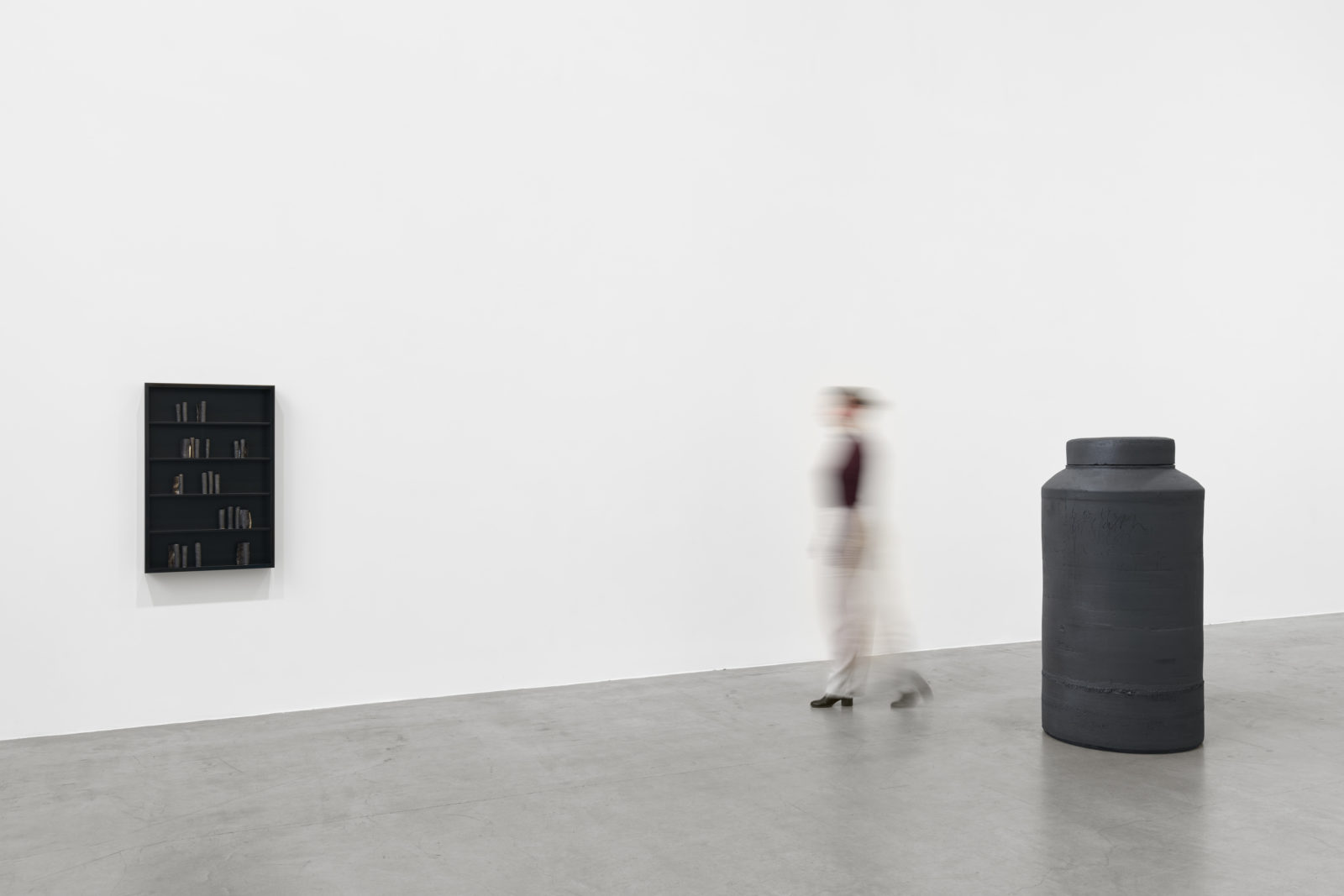
landfall, 2024; elegie, V, 2023
letters home
Galerie Max Hetzler, Berlin
14 June–10 August 2024
letters home is a solo exhibition of works by Edmund de Waal at Galerie Max Hetzler, Potsdamer Straße 77-87, Berlin. In addition to black, white and oak vitrines made this year, the exhibition includes both the largest free-standing clay vessels the artist has ever created, and a large-scale pavilion titled there are still songs to sing beyond mankind, 2024. Despite their differences in size and material, all the works are ultimately vessels whose interiors only seem to become more intimate as their dimensions increase.
Individual words or phrases from poems by Denise Riley (b. 1948), Paul Celan (1920–1970) and Rainer Maria Rilke (1875–1926) are interwoven in the titles or surfaces of these works by de Waal. Here, the focus is not on analysing the texts, but rather on their emotional heft. A further reference to language can be found in the forms of the vitrines, which seem reminiscent of pages from a book. The pavilion, also referred to as a kind of 'teahouse’ by de Waal, draws on the artist's memories of stays in Japan and his studies of sadō, the Japanese tea ceremony.
In dialogue not only with one another, but with history, literature and their surrounding space, de Waal’s works provide a place for pause, in his words, ‘letters home – my attempt to feel both the breath of separation and the pulse of connection’.
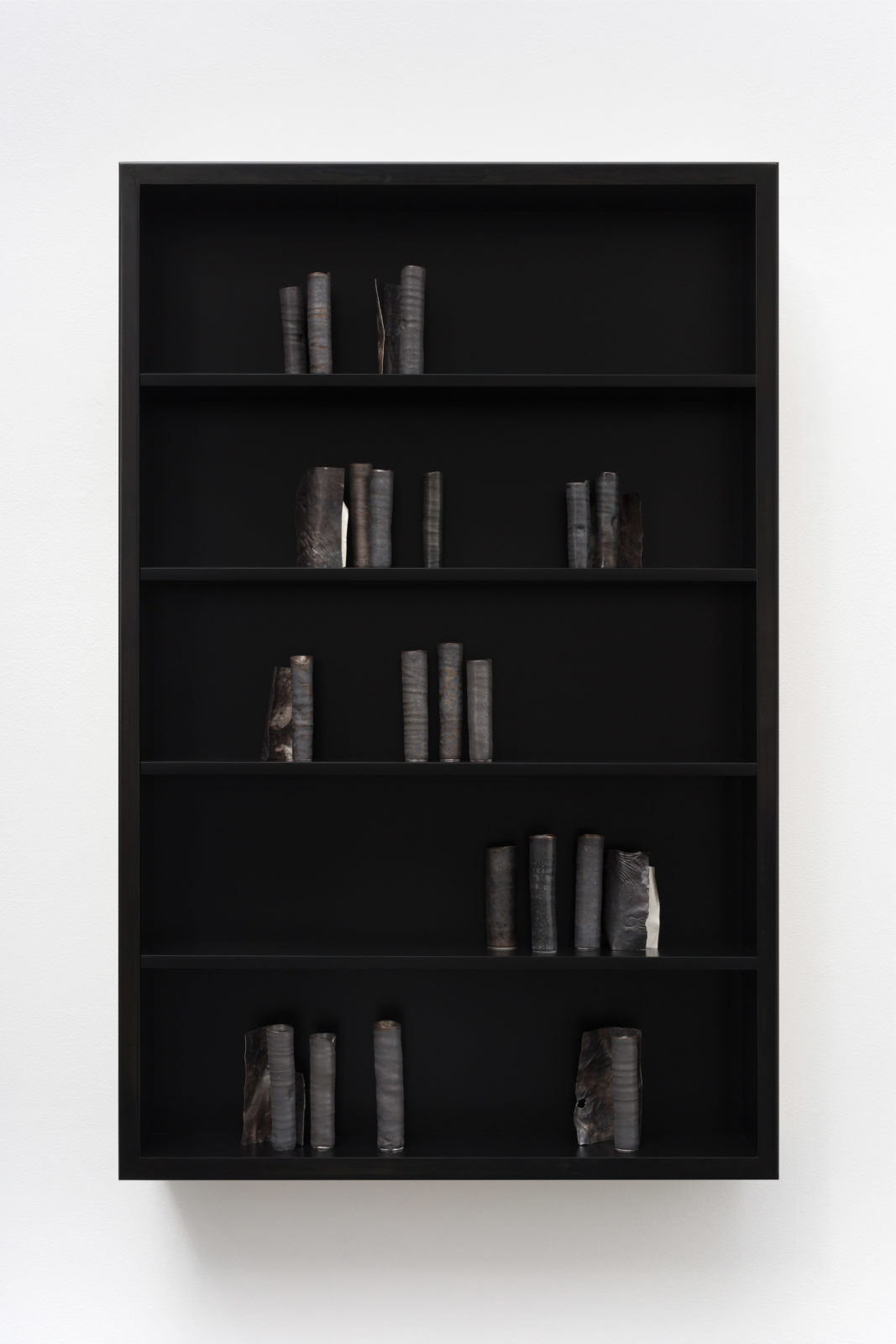
landfall2024
Porcelain, silver, wood, steel and glass
94 × 61 × 13 cm
letters home
Galerie Max Hetzler, Berlin
14 June–10 August 2024
letters home is a solo exhibition of works by Edmund de Waal at Galerie Max Hetzler, Potsdamer Straße 77-87, Berlin. In addition to black, white and oak vitrines made this year, the exhibition includes both the largest free-standing clay vessels the artist has ever created, and a large-scale pavilion titled there are still songs to sing beyond mankind, 2024. Despite their differences in size and material, all the works are ultimately vessels whose interiors only seem to become more intimate as their dimensions increase.
Individual words or phrases from poems by Denise Riley (b. 1948), Paul Celan (1920–1970) and Rainer Maria Rilke (1875–1926) are interwoven in the titles or surfaces of these works by de Waal. Here, the focus is not on analysing the texts, but rather on their emotional heft. A further reference to language can be found in the forms of the vitrines, which seem reminiscent of pages from a book. The pavilion, also referred to as a kind of 'teahouse’ by de Waal, draws on the artist's memories of stays in Japan and his studies of sadō, the Japanese tea ceremony.
In dialogue not only with one another, but with history, literature and their surrounding space, de Waal’s works provide a place for pause, in his words, ‘letters home – my attempt to feel both the breath of separation and the pulse of connection’.
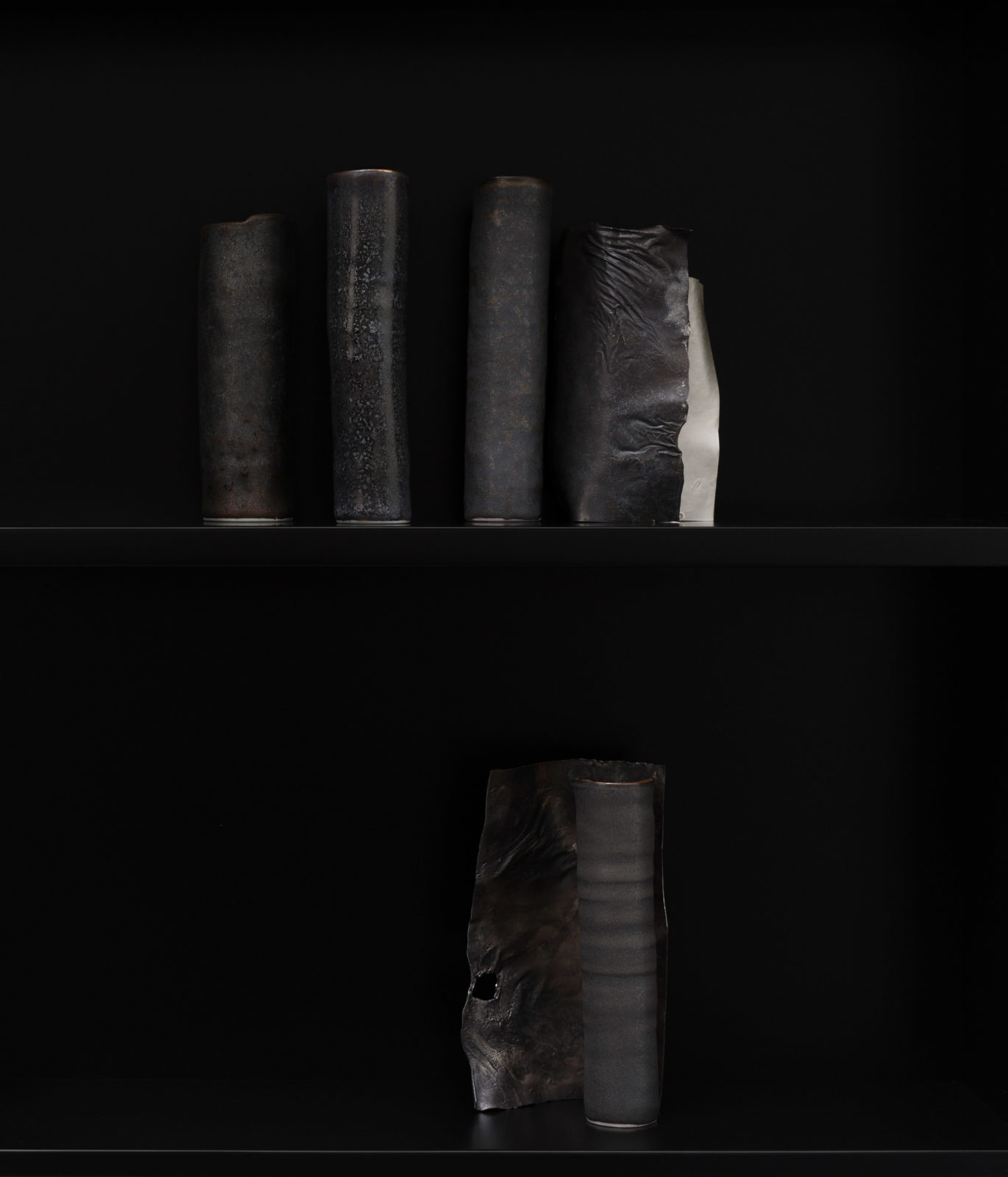
landfall (detail)2024
Porcelain, silver, wood, steel and glass
94 × 61 × 13 cm
letters home
Galerie Max Hetzler, Berlin
14 June–10 August 2024
letters home is a solo exhibition of works by Edmund de Waal at Galerie Max Hetzler, Potsdamer Straße 77-87, Berlin. In addition to black, white and oak vitrines made this year, the exhibition includes both the largest free-standing clay vessels the artist has ever created, and a large-scale pavilion titled there are still songs to sing beyond mankind, 2024. Despite their differences in size and material, all the works are ultimately vessels whose interiors only seem to become more intimate as their dimensions increase.
Individual words or phrases from poems by Denise Riley (b. 1948), Paul Celan (1920–1970) and Rainer Maria Rilke (1875–1926) are interwoven in the titles or surfaces of these works by de Waal. Here, the focus is not on analysing the texts, but rather on their emotional heft. A further reference to language can be found in the forms of the vitrines, which seem reminiscent of pages from a book. The pavilion, also referred to as a kind of 'teahouse’ by de Waal, draws on the artist's memories of stays in Japan and his studies of sadō, the Japanese tea ceremony.
In dialogue not only with one another, but with history, literature and their surrounding space, de Waal’s works provide a place for pause, in his words, ‘letters home – my attempt to feel both the breath of separation and the pulse of connection’.
letters home, installation view, 2024
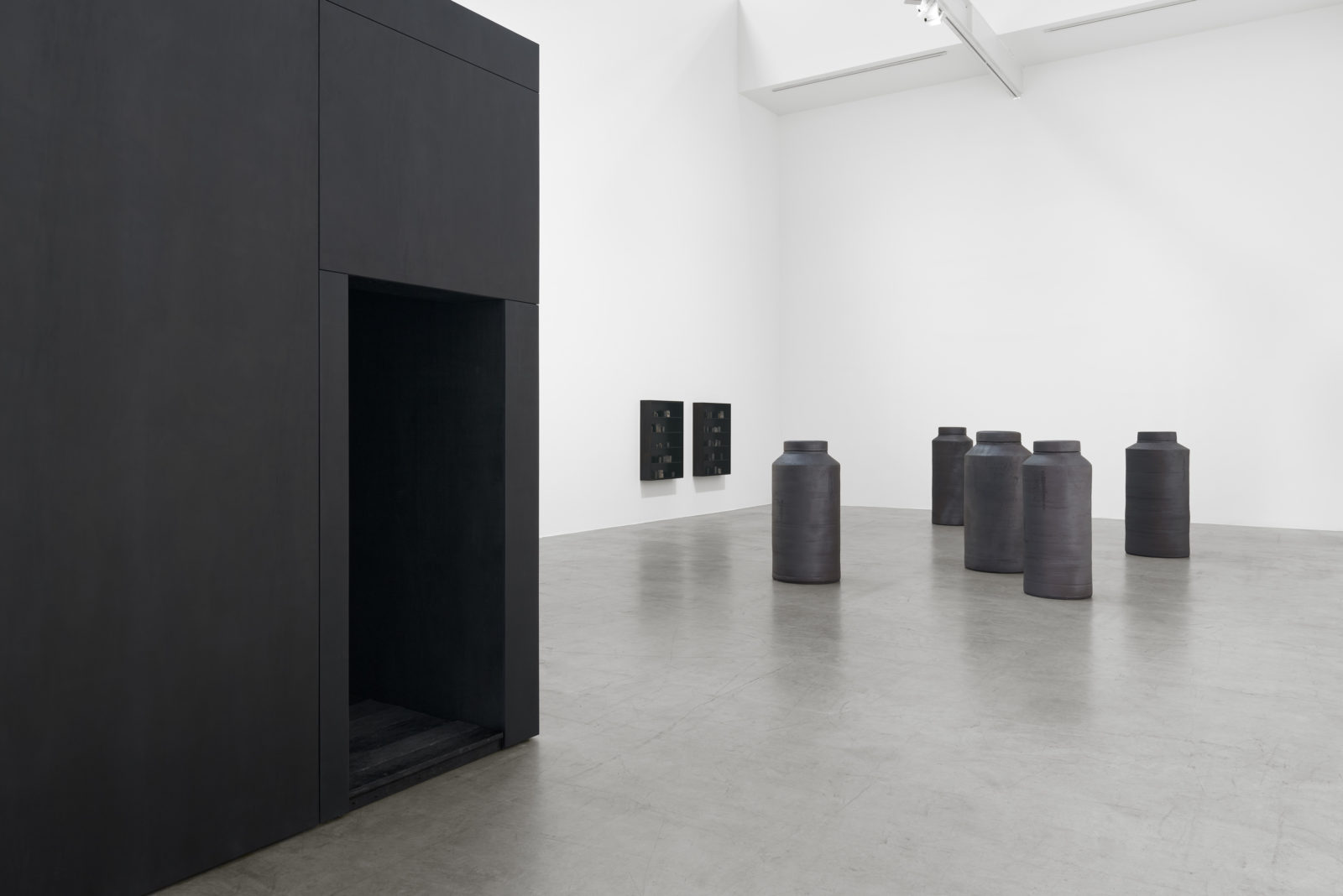
letters home, installation view, 2024
letters home
Galerie Max Hetzler, Berlin
14 June–10 August 2024
letters home is a solo exhibition of works by Edmund de Waal at Galerie Max Hetzler, Potsdamer Straße 77-87, Berlin. In addition to black, white and oak vitrines made this year, the exhibition includes both the largest free-standing clay vessels the artist has ever created, and a large-scale pavilion titled there are still songs to sing beyond mankind, 2024. Despite their differences in size and material, all the works are ultimately vessels whose interiors only seem to become more intimate as their dimensions increase.
Individual words or phrases from poems by Denise Riley (b. 1948), Paul Celan (1920–1970) and Rainer Maria Rilke (1875–1926) are interwoven in the titles or surfaces of these works by de Waal. Here, the focus is not on analysing the texts, but rather on their emotional heft. A further reference to language can be found in the forms of the vitrines, which seem reminiscent of pages from a book. The pavilion, also referred to as a kind of 'teahouse’ by de Waal, draws on the artist's memories of stays in Japan and his studies of sadō, the Japanese tea ceremony.
In dialogue not only with one another, but with history, literature and their surrounding space, de Waal’s works provide a place for pause, in his words, ‘letters home – my attempt to feel both the breath of separation and the pulse of connection’.
elegie, IV (detail), 2023
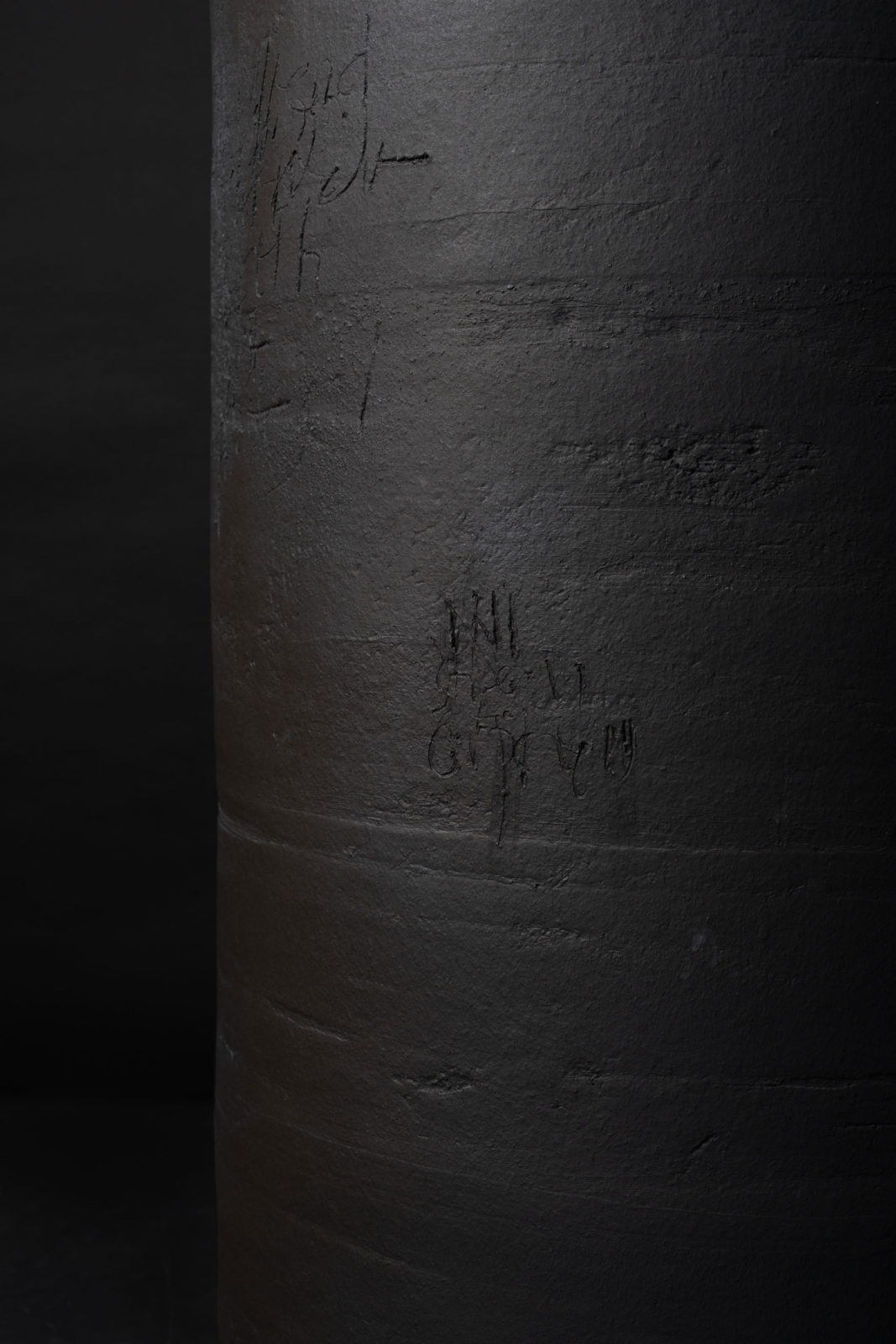
elegie, IV (detail), 2023
Stoneware vessel with inscription134 × 65.5 cm
letters home
Galerie Max Hetzler, Berlin
14 June–10 August 2024
letters home is a solo exhibition of works by Edmund de Waal at Galerie Max Hetzler, Potsdamer Straße 77-87, Berlin. In addition to black, white and oak vitrines made this year, the exhibition includes both the largest free-standing clay vessels the artist has ever created, and a large-scale pavilion titled there are still songs to sing beyond mankind, 2024. Despite their differences in size and material, all the works are ultimately vessels whose interiors only seem to become more intimate as their dimensions increase.
Individual words or phrases from poems by Denise Riley (b. 1948), Paul Celan (1920–1970) and Rainer Maria Rilke (1875–1926) are interwoven in the titles or surfaces of these works by de Waal. Here, the focus is not on analysing the texts, but rather on their emotional heft. A further reference to language can be found in the forms of the vitrines, which seem reminiscent of pages from a book. The pavilion, also referred to as a kind of 'teahouse’ by de Waal, draws on the artist's memories of stays in Japan and his studies of sadō, the Japanese tea ceremony.
In dialogue not only with one another, but with history, literature and their surrounding space, de Waal’s works provide a place for pause, in his words, ‘letters home – my attempt to feel both the breath of separation and the pulse of connection’.
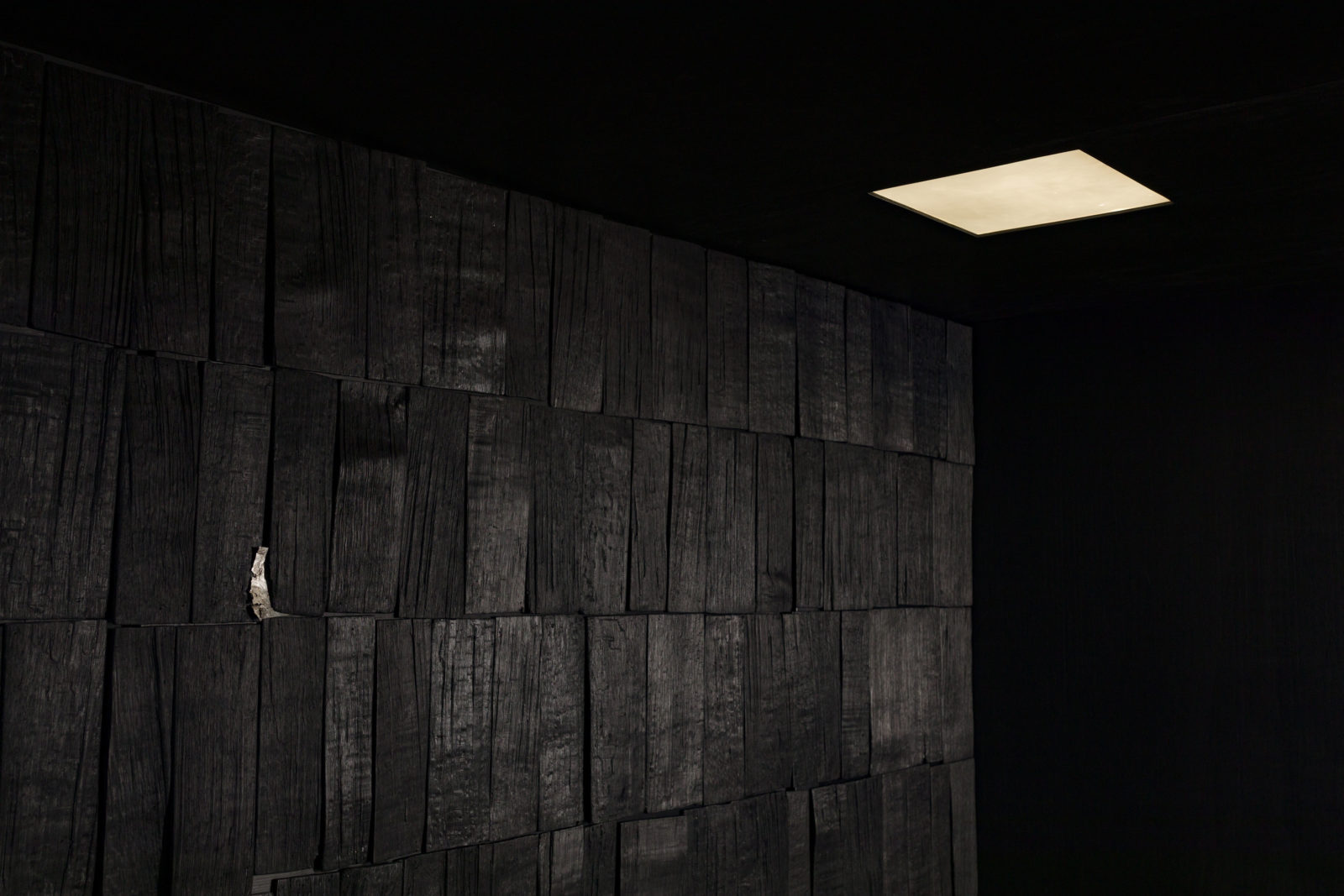
there are still songs to sing beyond mankind (detail)2024
Oak and poplar pavilion, holding 29 porcelain vessels, 1 porcelain tile and 6 silver pieces
330 × 370 × 286 cm
letters home
Galerie Max Hetzler, Berlin
14 June–10 August 2024
letters home is a solo exhibition of works by Edmund de Waal at Galerie Max Hetzler, Potsdamer Straße 77-87, Berlin. In addition to black, white and oak vitrines made this year, the exhibition includes both the largest free-standing clay vessels the artist has ever created, and a large-scale pavilion titled there are still songs to sing beyond mankind, 2024. Despite their differences in size and material, all the works are ultimately vessels whose interiors only seem to become more intimate as their dimensions increase.
Individual words or phrases from poems by Denise Riley (b. 1948), Paul Celan (1920–1970) and Rainer Maria Rilke (1875–1926) are interwoven in the titles or surfaces of these works by de Waal. Here, the focus is not on analysing the texts, but rather on their emotional heft. A further reference to language can be found in the forms of the vitrines, which seem reminiscent of pages from a book. The pavilion, also referred to as a kind of 'teahouse’ by de Waal, draws on the artist's memories of stays in Japan and his studies of sadō, the Japanese tea ceremony.
In dialogue not only with one another, but with history, literature and their surrounding space, de Waal’s works provide a place for pause, in his words, ‘letters home – my attempt to feel both the breath of separation and the pulse of connection’.
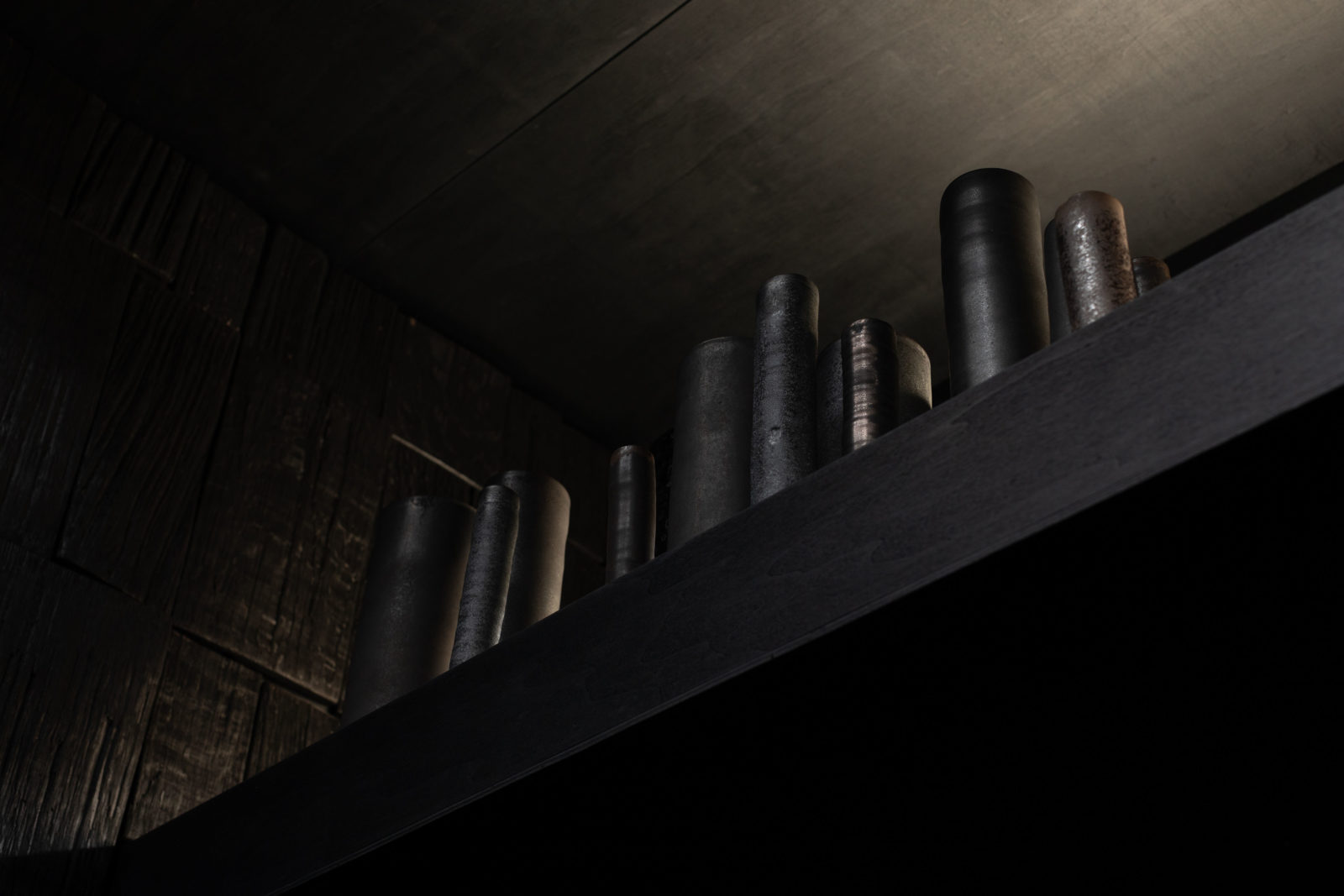
there are still songs to sing beyond mankind (detail)2024
Oak and poplar pavilion, holding 29 porcelain vessels, 1 porcelain tile and 6 silver pieces
330 × 370 × 286 cm
letters home
Galerie Max Hetzler, Berlin
14 June–10 August 2024
letters home is a solo exhibition of works by Edmund de Waal at Galerie Max Hetzler, Potsdamer Straße 77-87, Berlin. In addition to black, white and oak vitrines made this year, the exhibition includes both the largest free-standing clay vessels the artist has ever created, and a large-scale pavilion titled there are still songs to sing beyond mankind, 2024. Despite their differences in size and material, all the works are ultimately vessels whose interiors only seem to become more intimate as their dimensions increase.
Individual words or phrases from poems by Denise Riley (b. 1948), Paul Celan (1920–1970) and Rainer Maria Rilke (1875–1926) are interwoven in the titles or surfaces of these works by de Waal. Here, the focus is not on analysing the texts, but rather on their emotional heft. A further reference to language can be found in the forms of the vitrines, which seem reminiscent of pages from a book. The pavilion, also referred to as a kind of 'teahouse’ by de Waal, draws on the artist's memories of stays in Japan and his studies of sadō, the Japanese tea ceremony.
In dialogue not only with one another, but with history, literature and their surrounding space, de Waal’s works provide a place for pause, in his words, ‘letters home – my attempt to feel both the breath of separation and the pulse of connection’.
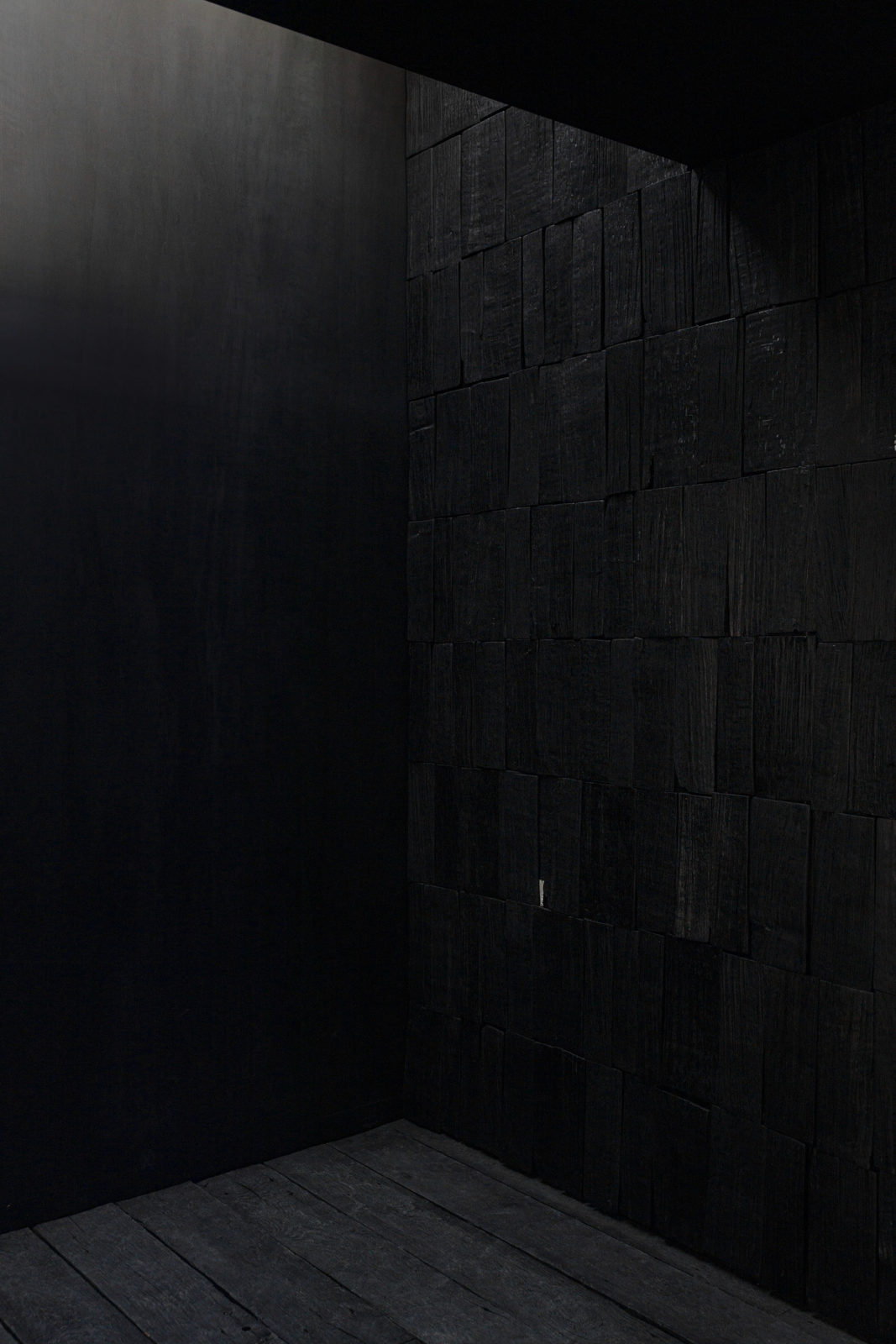
there are still songs to sing beyond mankind (detail)2024
Oak and poplar pavilion, holding 29 porcelain vessels, 1 porcelain tile and 6 silver pieces
330 × 370 × 286 cm
letters home
Galerie Max Hetzler, Berlin
14 June–10 August 2024
letters home is a solo exhibition of works by Edmund de Waal at Galerie Max Hetzler, Potsdamer Straße 77-87, Berlin. In addition to black, white and oak vitrines made this year, the exhibition includes both the largest free-standing clay vessels the artist has ever created, and a large-scale pavilion titled there are still songs to sing beyond mankind, 2024. Despite their differences in size and material, all the works are ultimately vessels whose interiors only seem to become more intimate as their dimensions increase.
Individual words or phrases from poems by Denise Riley (b. 1948), Paul Celan (1920–1970) and Rainer Maria Rilke (1875–1926) are interwoven in the titles or surfaces of these works by de Waal. Here, the focus is not on analysing the texts, but rather on their emotional heft. A further reference to language can be found in the forms of the vitrines, which seem reminiscent of pages from a book. The pavilion, also referred to as a kind of 'teahouse’ by de Waal, draws on the artist's memories of stays in Japan and his studies of sadō, the Japanese tea ceremony.
In dialogue not only with one another, but with history, literature and their surrounding space, de Waal’s works provide a place for pause, in his words, ‘letters home – my attempt to feel both the breath of separation and the pulse of connection’.
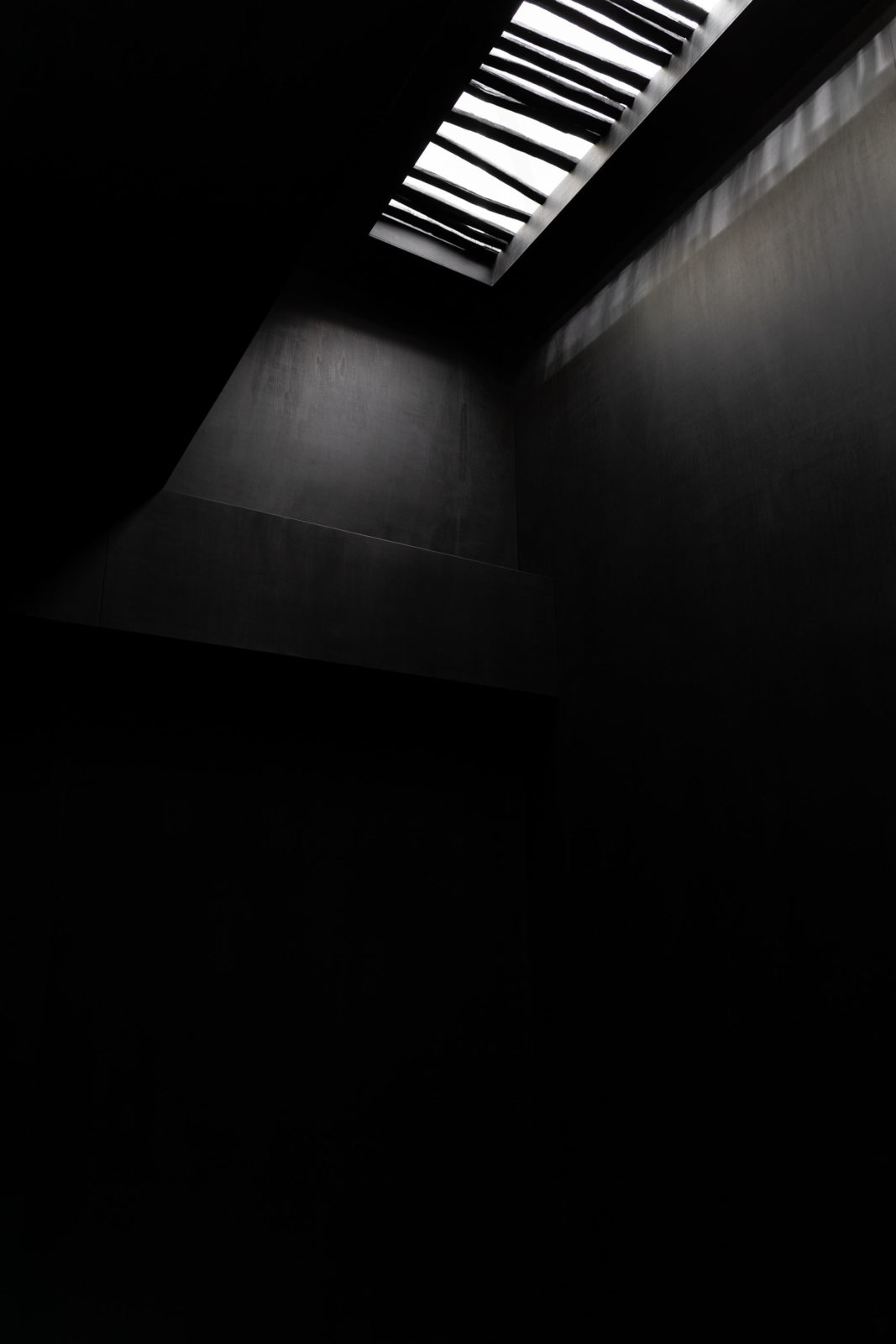
there are still songs to sing beyond mankind (detail)2024
Oak and poplar pavilion, holding 29 porcelain vessels, 1 porcelain tile and 6 silver pieces
330 × 370 × 286 cm
letters home
Galerie Max Hetzler, Berlin
14 June–10 August 2024
letters home is a solo exhibition of works by Edmund de Waal at Galerie Max Hetzler, Potsdamer Straße 77-87, Berlin. In addition to black, white and oak vitrines made this year, the exhibition includes both the largest free-standing clay vessels the artist has ever created, and a large-scale pavilion titled there are still songs to sing beyond mankind, 2024. Despite their differences in size and material, all the works are ultimately vessels whose interiors only seem to become more intimate as their dimensions increase.
Individual words or phrases from poems by Denise Riley (b. 1948), Paul Celan (1920–1970) and Rainer Maria Rilke (1875–1926) are interwoven in the titles or surfaces of these works by de Waal. Here, the focus is not on analysing the texts, but rather on their emotional heft. A further reference to language can be found in the forms of the vitrines, which seem reminiscent of pages from a book. The pavilion, also referred to as a kind of 'teahouse’ by de Waal, draws on the artist's memories of stays in Japan and his studies of sadō, the Japanese tea ceremony.
In dialogue not only with one another, but with history, literature and their surrounding space, de Waal’s works provide a place for pause, in his words, ‘letters home – my attempt to feel both the breath of separation and the pulse of connection’.
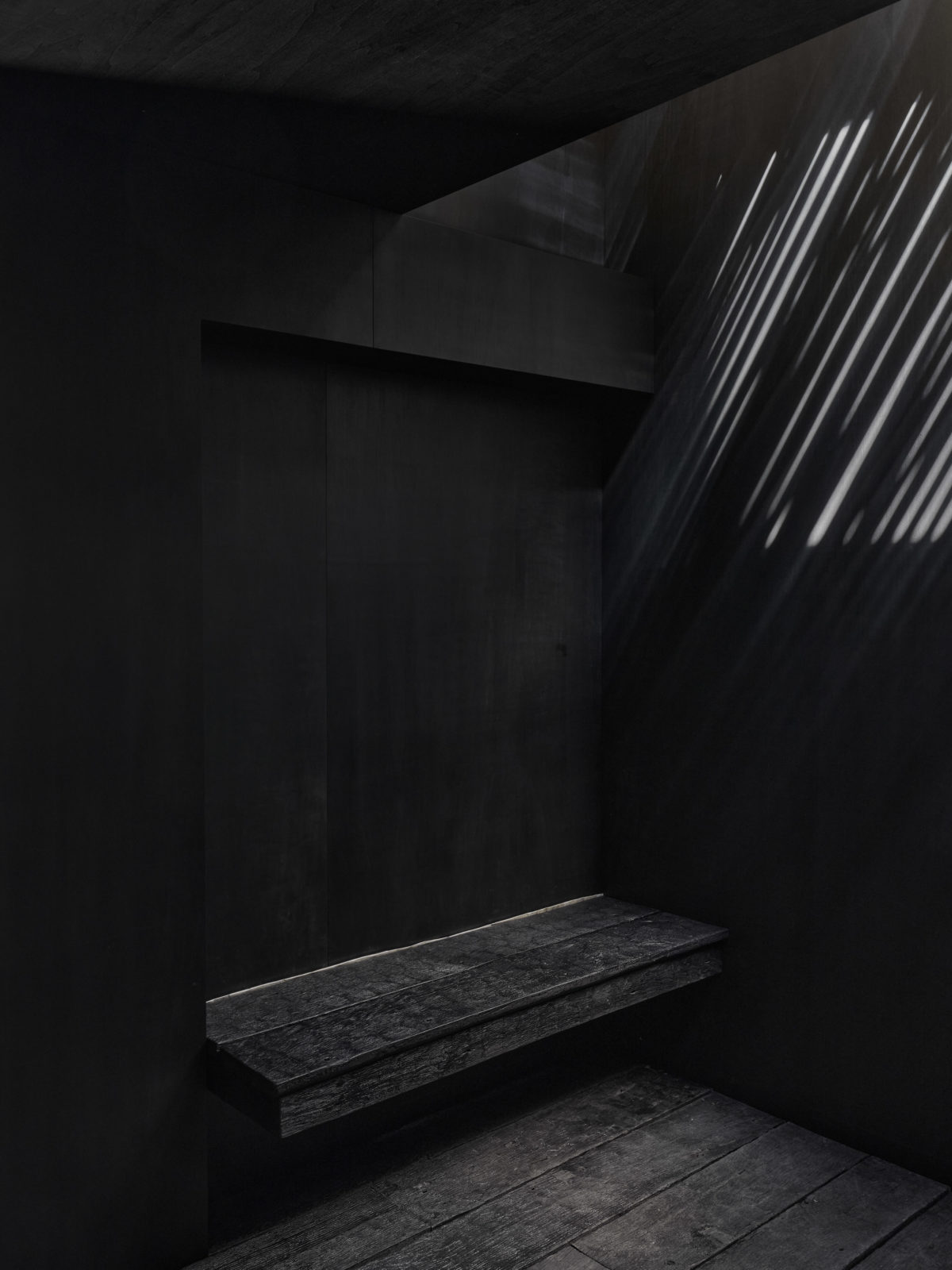
there are still songs to sing beyond mankind2024
Oak and poplar pavilion, holding 29 porcelain vessels, 1 porcelain tile and 6 silver pieces
330 × 370 × 286 cm
letters home
Galerie Max Hetzler, Berlin
14 June–10 August 2024
letters home is a solo exhibition of works by Edmund de Waal at Galerie Max Hetzler, Potsdamer Straße 77-87, Berlin. In addition to black, white and oak vitrines made this year, the exhibition includes both the largest free-standing clay vessels the artist has ever created, and a large-scale pavilion titled there are still songs to sing beyond mankind, 2024. Despite their differences in size and material, all the works are ultimately vessels whose interiors only seem to become more intimate as their dimensions increase.
Individual words or phrases from poems by Denise Riley (b. 1948), Paul Celan (1920–1970) and Rainer Maria Rilke (1875–1926) are interwoven in the titles or surfaces of these works by de Waal. Here, the focus is not on analysing the texts, but rather on their emotional heft. A further reference to language can be found in the forms of the vitrines, which seem reminiscent of pages from a book. The pavilion, also referred to as a kind of 'teahouse’ by de Waal, draws on the artist's memories of stays in Japan and his studies of sadō, the Japanese tea ceremony.
In dialogue not only with one another, but with history, literature and their surrounding space, de Waal’s works provide a place for pause, in his words, ‘letters home – my attempt to feel both the breath of separation and the pulse of connection’.
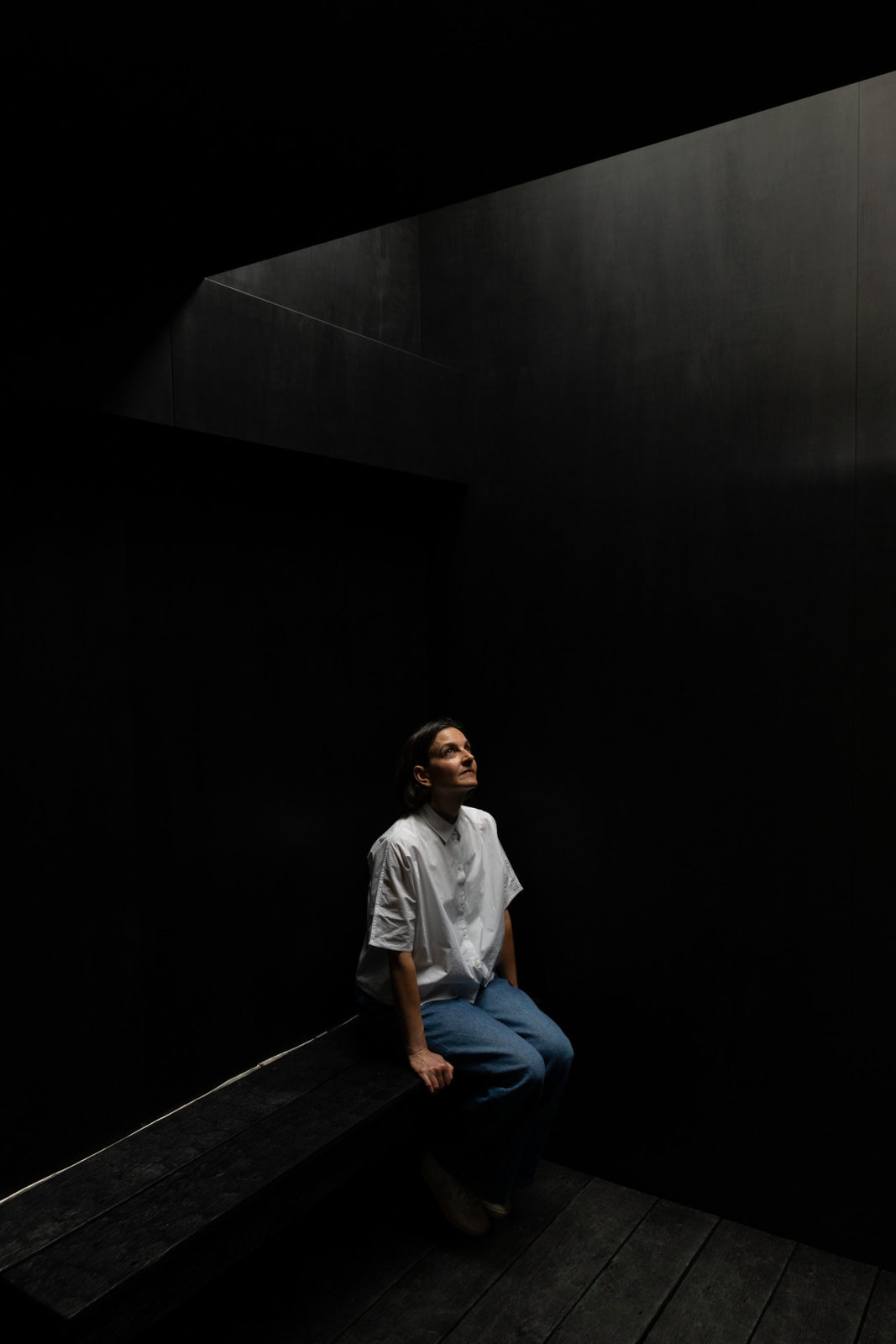
there are still songs to sing beyond mankind (detail)2024
Oak and poplar pavilion, holding 29 porcelain vessels, 1 porcelain tile and 6 silver pieces
330 × 370 × 286 cm
letters home
Galerie Max Hetzler, Berlin
14 June–10 August 2024
letters home is a solo exhibition of works by Edmund de Waal at Galerie Max Hetzler, Potsdamer Straße 77-87, Berlin. In addition to black, white and oak vitrines made this year, the exhibition includes both the largest free-standing clay vessels the artist has ever created, and a large-scale pavilion titled there are still songs to sing beyond mankind, 2024. Despite their differences in size and material, all the works are ultimately vessels whose interiors only seem to become more intimate as their dimensions increase.
Individual words or phrases from poems by Denise Riley (b. 1948), Paul Celan (1920–1970) and Rainer Maria Rilke (1875–1926) are interwoven in the titles or surfaces of these works by de Waal. Here, the focus is not on analysing the texts, but rather on their emotional heft. A further reference to language can be found in the forms of the vitrines, which seem reminiscent of pages from a book. The pavilion, also referred to as a kind of 'teahouse’ by de Waal, draws on the artist's memories of stays in Japan and his studies of sadō, the Japanese tea ceremony.
In dialogue not only with one another, but with history, literature and their surrounding space, de Waal’s works provide a place for pause, in his words, ‘letters home – my attempt to feel both the breath of separation and the pulse of connection’.
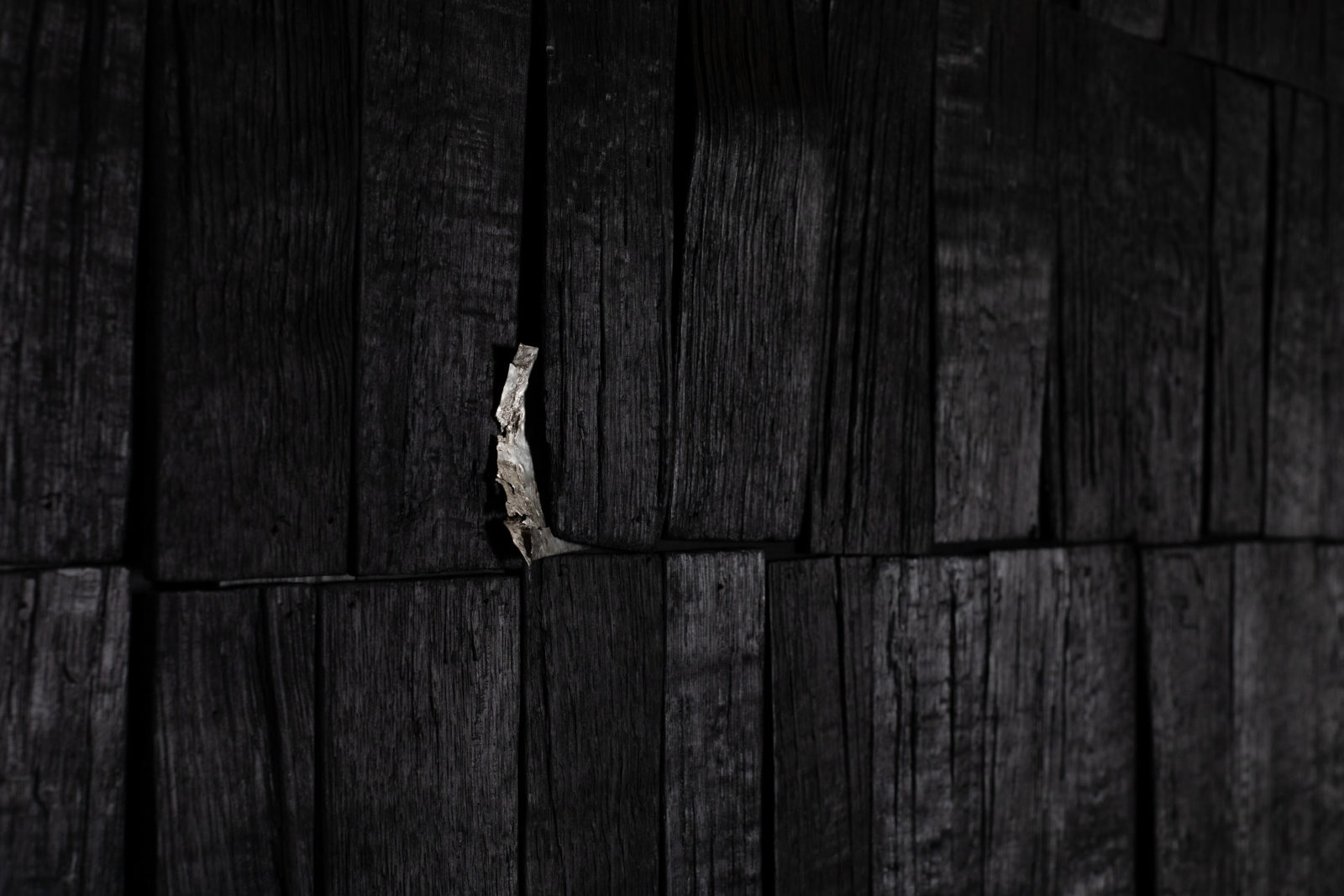
there are still songs to sing beyond mankind (detail)2024
Oak and poplar pavilion, holding 29 porcelain vessels, 1 porcelain tile and 6 silver pieces
330 × 370 × 286 cm
letters home
Galerie Max Hetzler, Berlin
14 June–10 August 2024
letters home is a solo exhibition of works by Edmund de Waal at Galerie Max Hetzler, Potsdamer Straße 77-87, Berlin. In addition to black, white and oak vitrines made this year, the exhibition includes both the largest free-standing clay vessels the artist has ever created, and a large-scale pavilion titled there are still songs to sing beyond mankind, 2024. Despite their differences in size and material, all the works are ultimately vessels whose interiors only seem to become more intimate as their dimensions increase.
Individual words or phrases from poems by Denise Riley (b. 1948), Paul Celan (1920–1970) and Rainer Maria Rilke (1875–1926) are interwoven in the titles or surfaces of these works by de Waal. Here, the focus is not on analysing the texts, but rather on their emotional heft. A further reference to language can be found in the forms of the vitrines, which seem reminiscent of pages from a book. The pavilion, also referred to as a kind of 'teahouse’ by de Waal, draws on the artist's memories of stays in Japan and his studies of sadō, the Japanese tea ceremony.
In dialogue not only with one another, but with history, literature and their surrounding space, de Waal’s works provide a place for pause, in his words, ‘letters home – my attempt to feel both the breath of separation and the pulse of connection’.
letters home, installation view, 2024
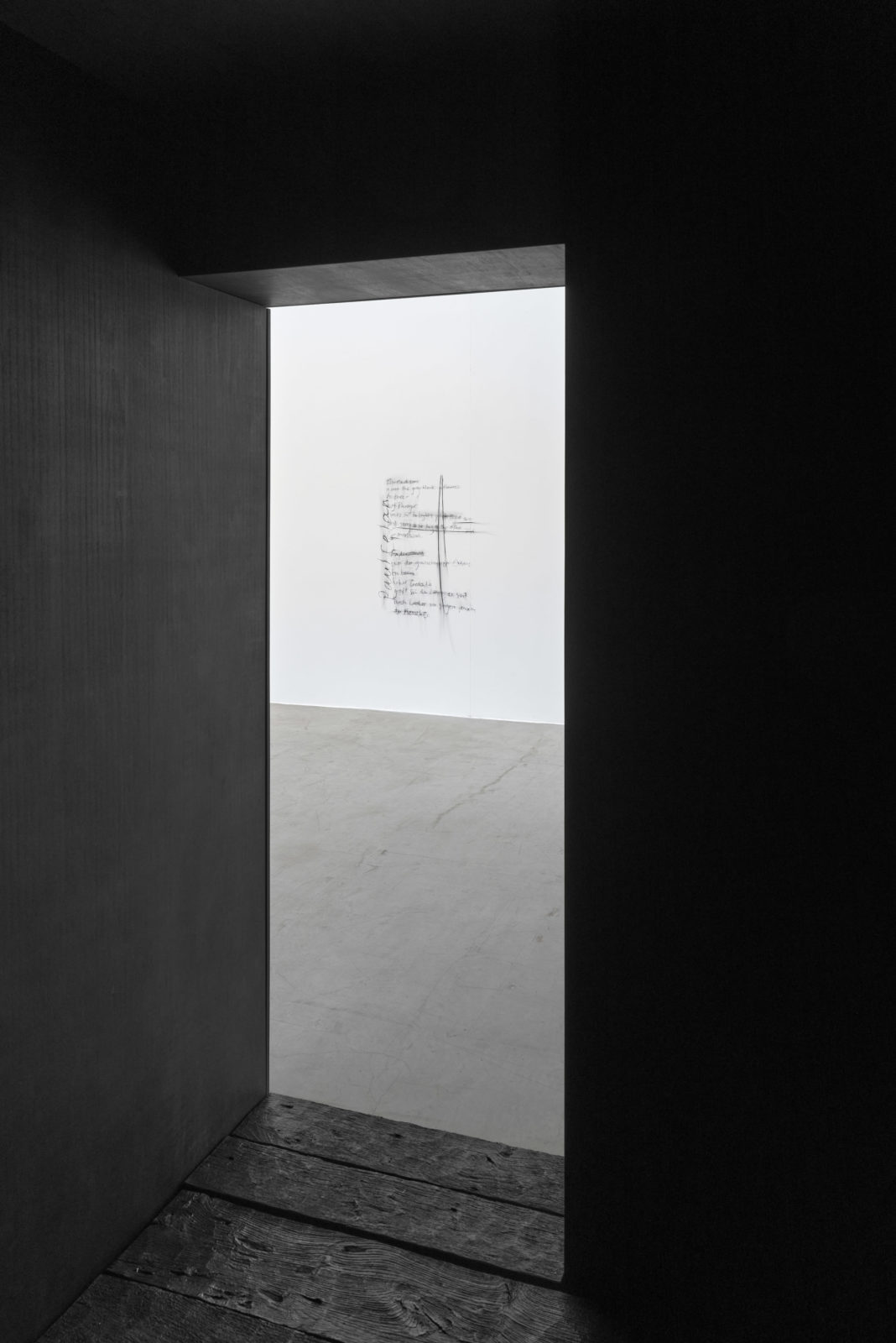
letters home, installation view, 2024
letters home
Galerie Max Hetzler, Berlin
14 June–10 August 2024
letters home is a solo exhibition of works by Edmund de Waal at Galerie Max Hetzler, Potsdamer Straße 77-87, Berlin. In addition to black, white and oak vitrines made this year, the exhibition includes both the largest free-standing clay vessels the artist has ever created, and a large-scale pavilion titled there are still songs to sing beyond mankind, 2024. Despite their differences in size and material, all the works are ultimately vessels whose interiors only seem to become more intimate as their dimensions increase.
Individual words or phrases from poems by Denise Riley (b. 1948), Paul Celan (1920–1970) and Rainer Maria Rilke (1875–1926) are interwoven in the titles or surfaces of these works by de Waal. Here, the focus is not on analysing the texts, but rather on their emotional heft. A further reference to language can be found in the forms of the vitrines, which seem reminiscent of pages from a book. The pavilion, also referred to as a kind of 'teahouse’ by de Waal, draws on the artist's memories of stays in Japan and his studies of sadō, the Japanese tea ceremony.
In dialogue not only with one another, but with history, literature and their surrounding space, de Waal’s works provide a place for pause, in his words, ‘letters home – my attempt to feel both the breath of separation and the pulse of connection’.
letters home, installation view, 2024
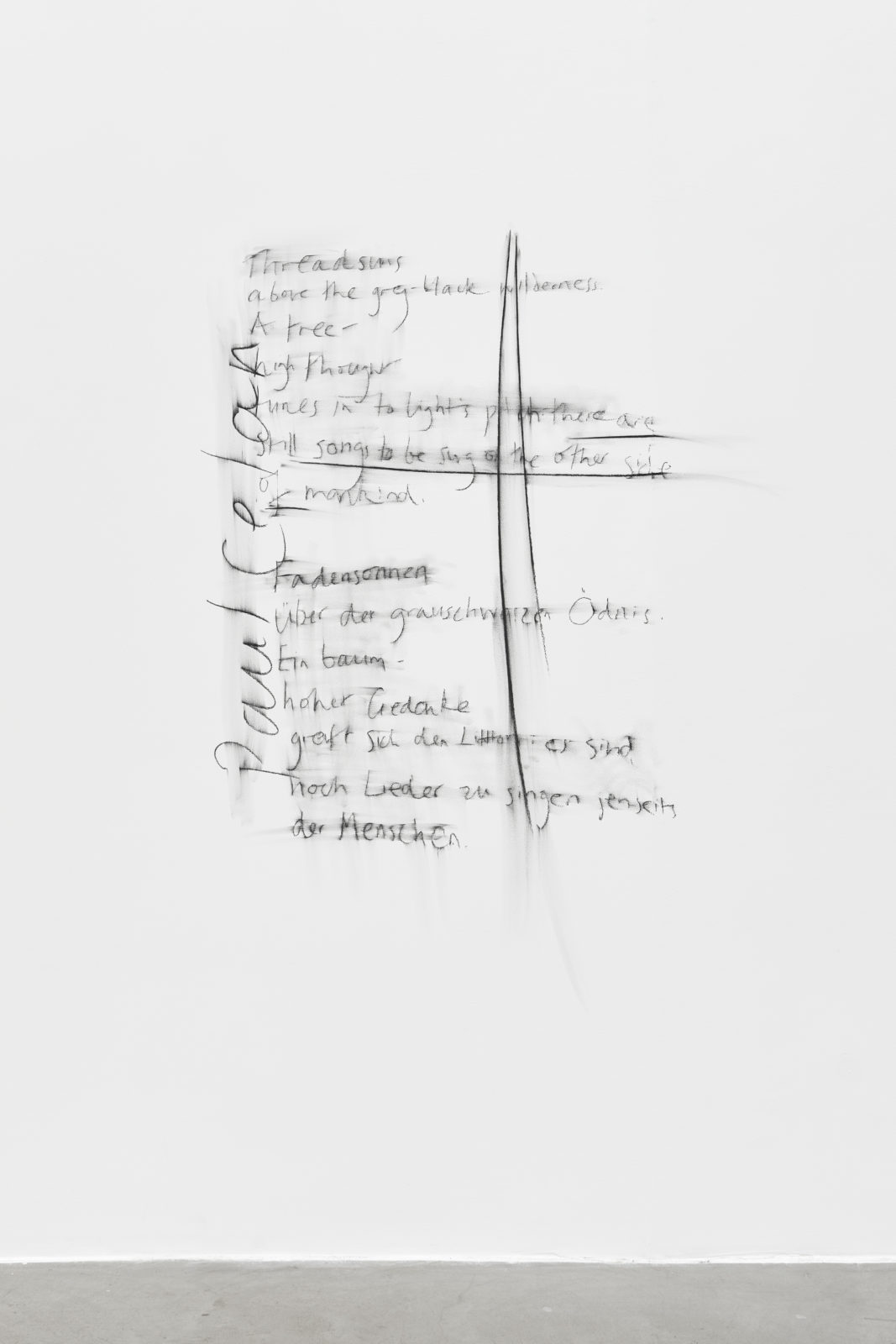
letters home, installation view, 2024
letters home
Galerie Max Hetzler, Berlin
14 June–10 August 2024
letters home is a solo exhibition of works by Edmund de Waal at Galerie Max Hetzler, Potsdamer Straße 77-87, Berlin. In addition to black, white and oak vitrines made this year, the exhibition includes both the largest free-standing clay vessels the artist has ever created, and a large-scale pavilion titled there are still songs to sing beyond mankind, 2024. Despite their differences in size and material, all the works are ultimately vessels whose interiors only seem to become more intimate as their dimensions increase.
Individual words or phrases from poems by Denise Riley (b. 1948), Paul Celan (1920–1970) and Rainer Maria Rilke (1875–1926) are interwoven in the titles or surfaces of these works by de Waal. Here, the focus is not on analysing the texts, but rather on their emotional heft. A further reference to language can be found in the forms of the vitrines, which seem reminiscent of pages from a book. The pavilion, also referred to as a kind of 'teahouse’ by de Waal, draws on the artist's memories of stays in Japan and his studies of sadō, the Japanese tea ceremony.
In dialogue not only with one another, but with history, literature and their surrounding space, de Waal’s works provide a place for pause, in his words, ‘letters home – my attempt to feel both the breath of separation and the pulse of connection’.
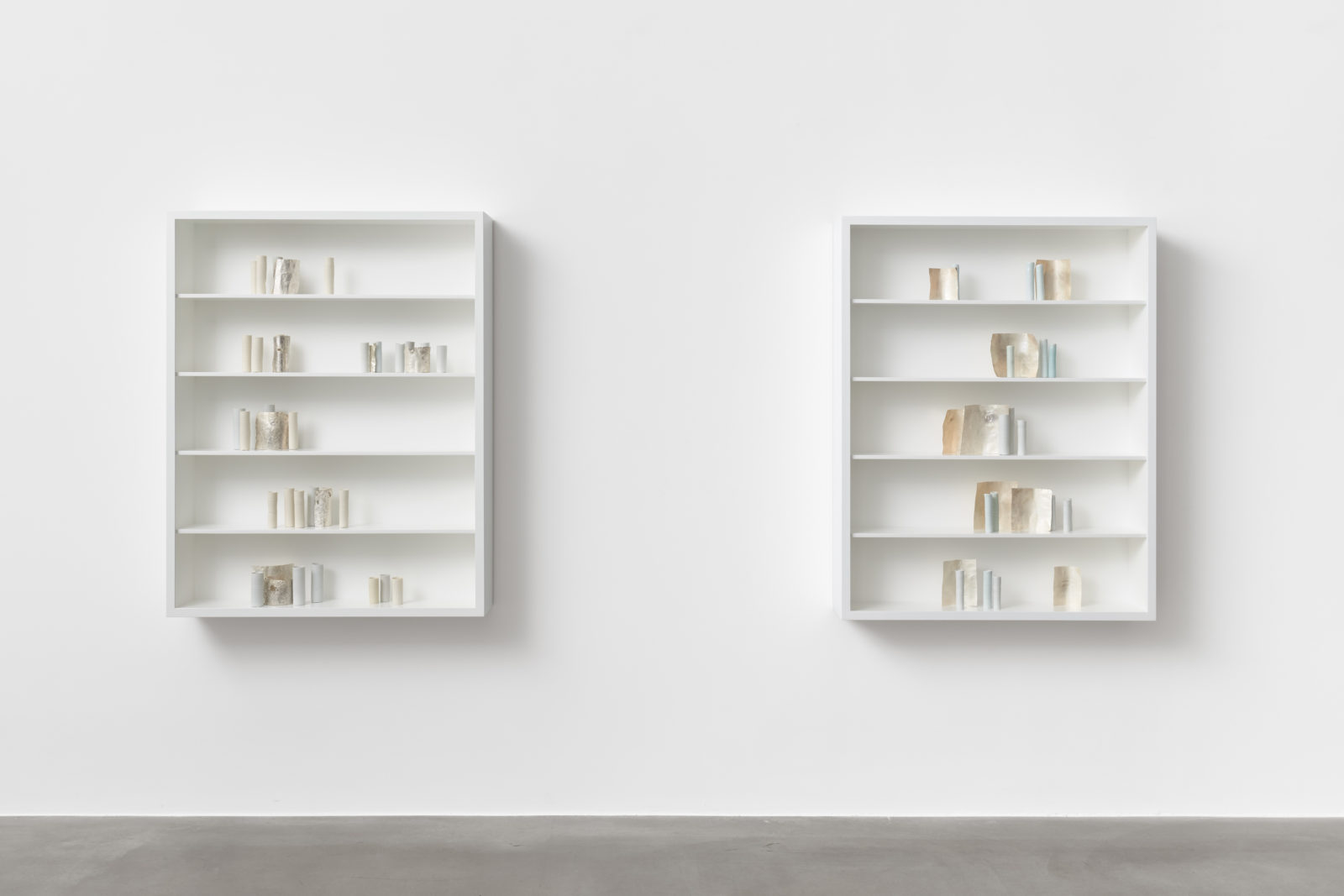
untitled (let no air now be sung); untitled (brightness falls from the air)2024
Porcelain, silver, aluminium, wood and glass
Each vitrine 122 × 95 × 19 cm
letters home
Galerie Max Hetzler, Berlin
14 June–10 August 2024
letters home is a solo exhibition of works by Edmund de Waal at Galerie Max Hetzler, Potsdamer Straße 77-87, Berlin. In addition to black, white and oak vitrines made this year, the exhibition includes both the largest free-standing clay vessels the artist has ever created, and a large-scale pavilion titled there are still songs to sing beyond mankind, 2024. Despite their differences in size and material, all the works are ultimately vessels whose interiors only seem to become more intimate as their dimensions increase.
Individual words or phrases from poems by Denise Riley (b. 1948), Paul Celan (1920–1970) and Rainer Maria Rilke (1875–1926) are interwoven in the titles or surfaces of these works by de Waal. Here, the focus is not on analysing the texts, but rather on their emotional heft. A further reference to language can be found in the forms of the vitrines, which seem reminiscent of pages from a book. The pavilion, also referred to as a kind of 'teahouse’ by de Waal, draws on the artist's memories of stays in Japan and his studies of sadō, the Japanese tea ceremony.
In dialogue not only with one another, but with history, literature and their surrounding space, de Waal’s works provide a place for pause, in his words, ‘letters home – my attempt to feel both the breath of separation and the pulse of connection’.
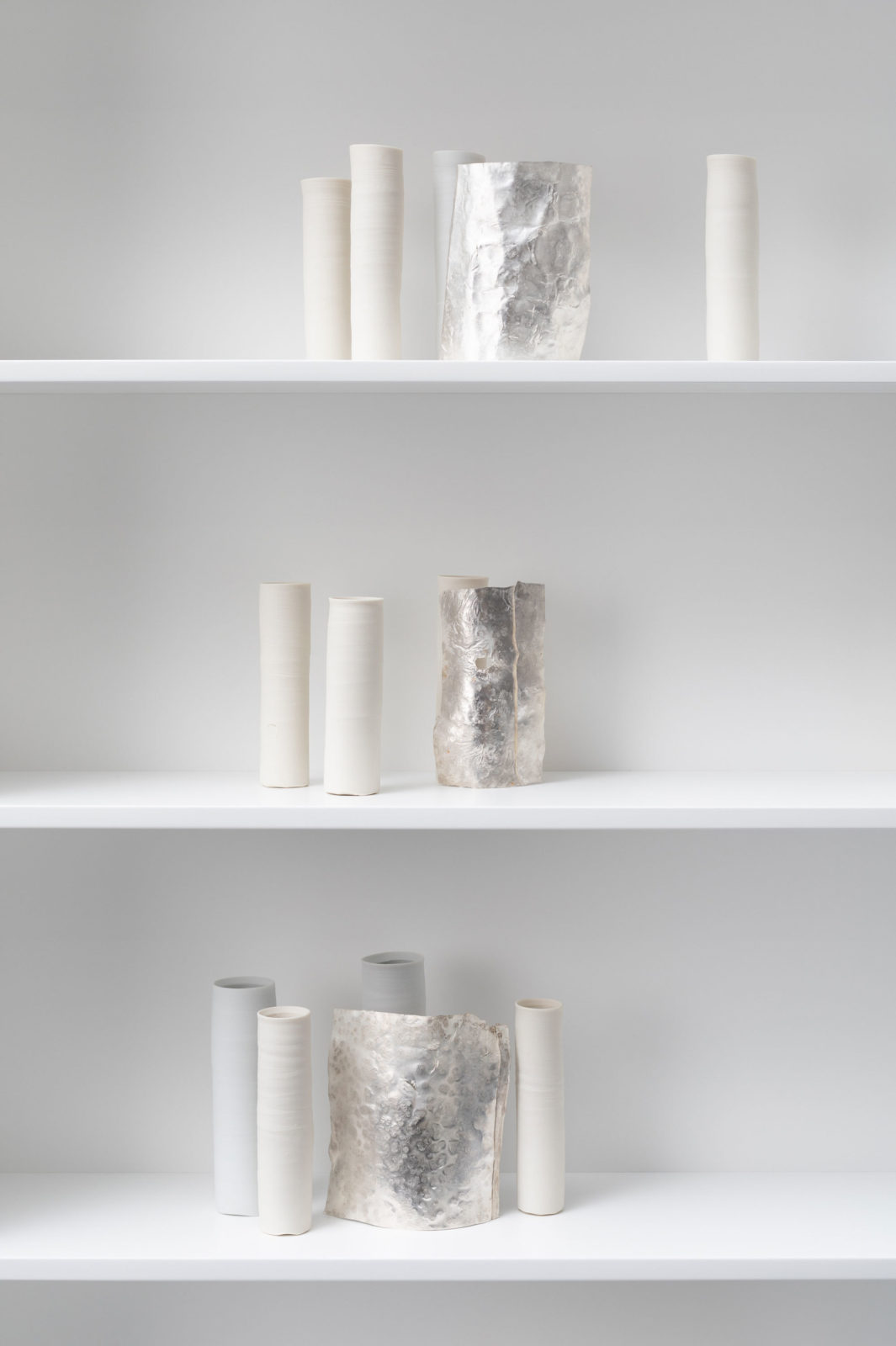
untitled (let no air now be sung) (detail)2024
Porcelain, silver, aluminium, wood and glass
122 × 95 × 19 cm
letters home
Galerie Max Hetzler, Berlin
14 June–10 August 2024
letters home is a solo exhibition of works by Edmund de Waal at Galerie Max Hetzler, Potsdamer Straße 77-87, Berlin. In addition to black, white and oak vitrines made this year, the exhibition includes both the largest free-standing clay vessels the artist has ever created, and a large-scale pavilion titled there are still songs to sing beyond mankind, 2024. Despite their differences in size and material, all the works are ultimately vessels whose interiors only seem to become more intimate as their dimensions increase.
Individual words or phrases from poems by Denise Riley (b. 1948), Paul Celan (1920–1970) and Rainer Maria Rilke (1875–1926) are interwoven in the titles or surfaces of these works by de Waal. Here, the focus is not on analysing the texts, but rather on their emotional heft. A further reference to language can be found in the forms of the vitrines, which seem reminiscent of pages from a book. The pavilion, also referred to as a kind of 'teahouse’ by de Waal, draws on the artist's memories of stays in Japan and his studies of sadō, the Japanese tea ceremony.
In dialogue not only with one another, but with history, literature and their surrounding space, de Waal’s works provide a place for pause, in his words, ‘letters home – my attempt to feel both the breath of separation and the pulse of connection’.
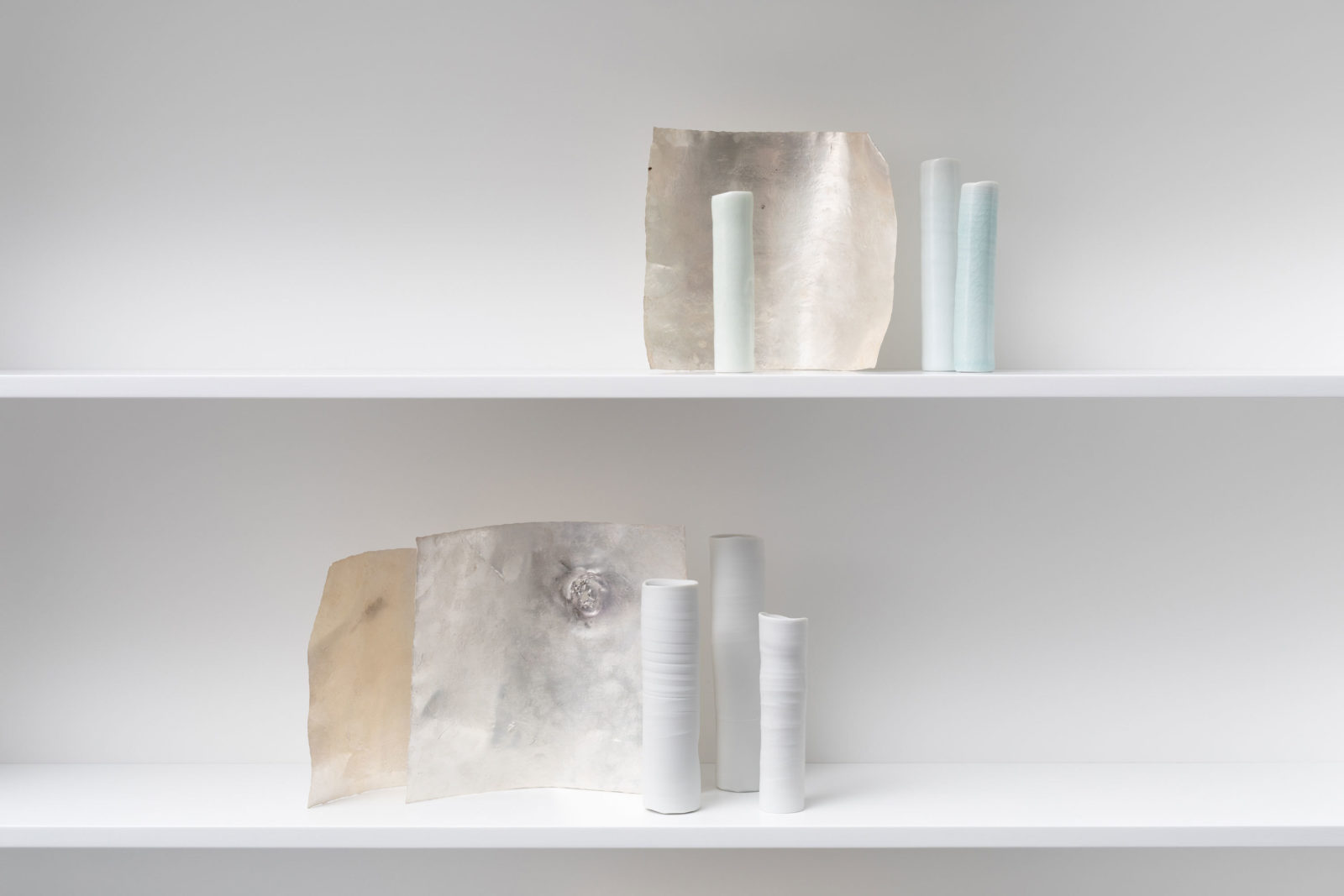
untitled (brightness falls from the air) (detail)2024
Porcelain, silver, aluminium, wood and glass
122 × 95 × 19 cm
letters home
Galerie Max Hetzler, Berlin
14 June–10 August 2024
letters home is a solo exhibition of works by Edmund de Waal at Galerie Max Hetzler, Potsdamer Straße 77-87, Berlin. In addition to black, white and oak vitrines made this year, the exhibition includes both the largest free-standing clay vessels the artist has ever created, and a large-scale pavilion titled there are still songs to sing beyond mankind, 2024. Despite their differences in size and material, all the works are ultimately vessels whose interiors only seem to become more intimate as their dimensions increase.
Individual words or phrases from poems by Denise Riley (b. 1948), Paul Celan (1920–1970) and Rainer Maria Rilke (1875–1926) are interwoven in the titles or surfaces of these works by de Waal. Here, the focus is not on analysing the texts, but rather on their emotional heft. A further reference to language can be found in the forms of the vitrines, which seem reminiscent of pages from a book. The pavilion, also referred to as a kind of 'teahouse’ by de Waal, draws on the artist's memories of stays in Japan and his studies of sadō, the Japanese tea ceremony.
In dialogue not only with one another, but with history, literature and their surrounding space, de Waal’s works provide a place for pause, in his words, ‘letters home – my attempt to feel both the breath of separation and the pulse of connection’.
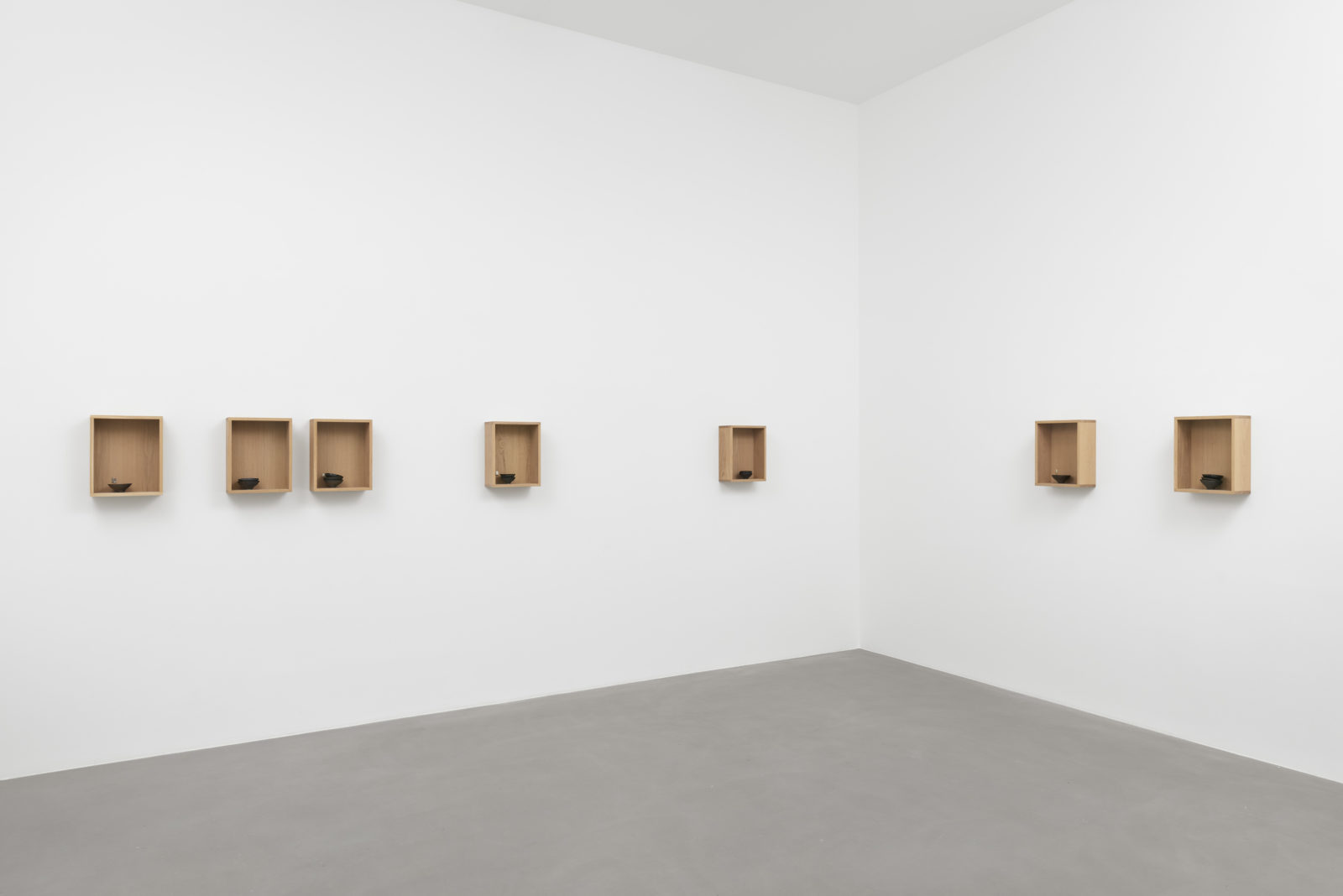
so much depends, II–VIII2024
Each vitrine 37 × 30 × 15 cm
Porcelain, silver, oak, and glass
letters home
Galerie Max Hetzler, Berlin
14 June–10 August 2024
letters home is a solo exhibition of works by Edmund de Waal at Galerie Max Hetzler, Potsdamer Straße 77-87, Berlin. In addition to black, white and oak vitrines made this year, the exhibition includes both the largest free-standing clay vessels the artist has ever created, and a large-scale pavilion titled there are still songs to sing beyond mankind, 2024. Despite their differences in size and material, all the works are ultimately vessels whose interiors only seem to become more intimate as their dimensions increase.
Individual words or phrases from poems by Denise Riley (b. 1948), Paul Celan (1920–1970) and Rainer Maria Rilke (1875–1926) are interwoven in the titles or surfaces of these works by de Waal. Here, the focus is not on analysing the texts, but rather on their emotional heft. A further reference to language can be found in the forms of the vitrines, which seem reminiscent of pages from a book. The pavilion, also referred to as a kind of 'teahouse’ by de Waal, draws on the artist's memories of stays in Japan and his studies of sadō, the Japanese tea ceremony.
In dialogue not only with one another, but with history, literature and their surrounding space, de Waal’s works provide a place for pause, in his words, ‘letters home – my attempt to feel both the breath of separation and the pulse of connection’.
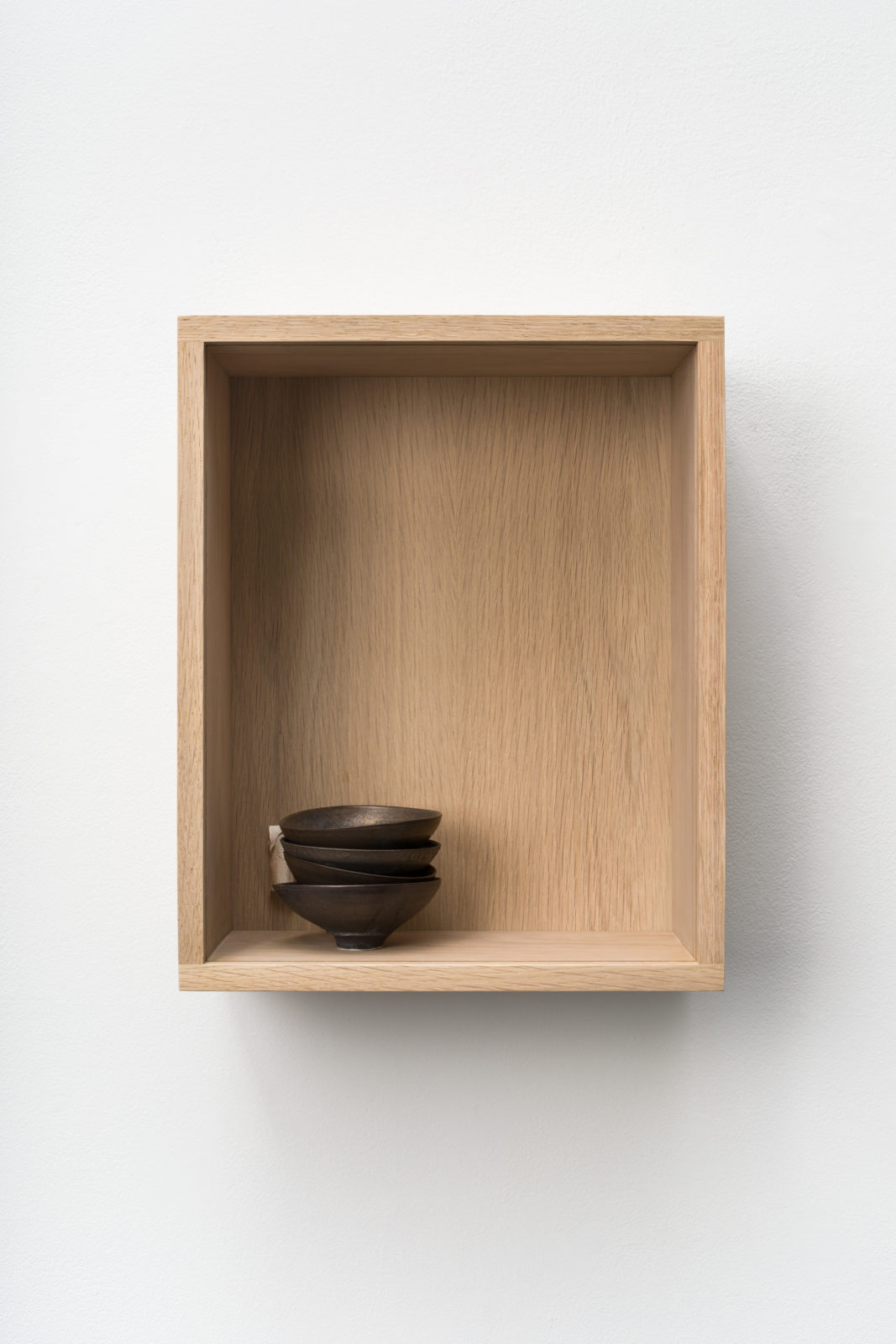
so much depends, I2024
Porcelain, silver, oak, and glass
37 × 30 × 15 cm
letters home
Galerie Max Hetzler, Berlin
14 June–10 August 2024
letters home is a solo exhibition of works by Edmund de Waal at Galerie Max Hetzler, Potsdamer Straße 77-87, Berlin. In addition to black, white and oak vitrines made this year, the exhibition includes both the largest free-standing clay vessels the artist has ever created, and a large-scale pavilion titled there are still songs to sing beyond mankind, 2024. Despite their differences in size and material, all the works are ultimately vessels whose interiors only seem to become more intimate as their dimensions increase.
Individual words or phrases from poems by Denise Riley (b. 1948), Paul Celan (1920–1970) and Rainer Maria Rilke (1875–1926) are interwoven in the titles or surfaces of these works by de Waal. Here, the focus is not on analysing the texts, but rather on their emotional heft. A further reference to language can be found in the forms of the vitrines, which seem reminiscent of pages from a book. The pavilion, also referred to as a kind of 'teahouse’ by de Waal, draws on the artist's memories of stays in Japan and his studies of sadō, the Japanese tea ceremony.
In dialogue not only with one another, but with history, literature and their surrounding space, de Waal’s works provide a place for pause, in his words, ‘letters home – my attempt to feel both the breath of separation and the pulse of connection’.
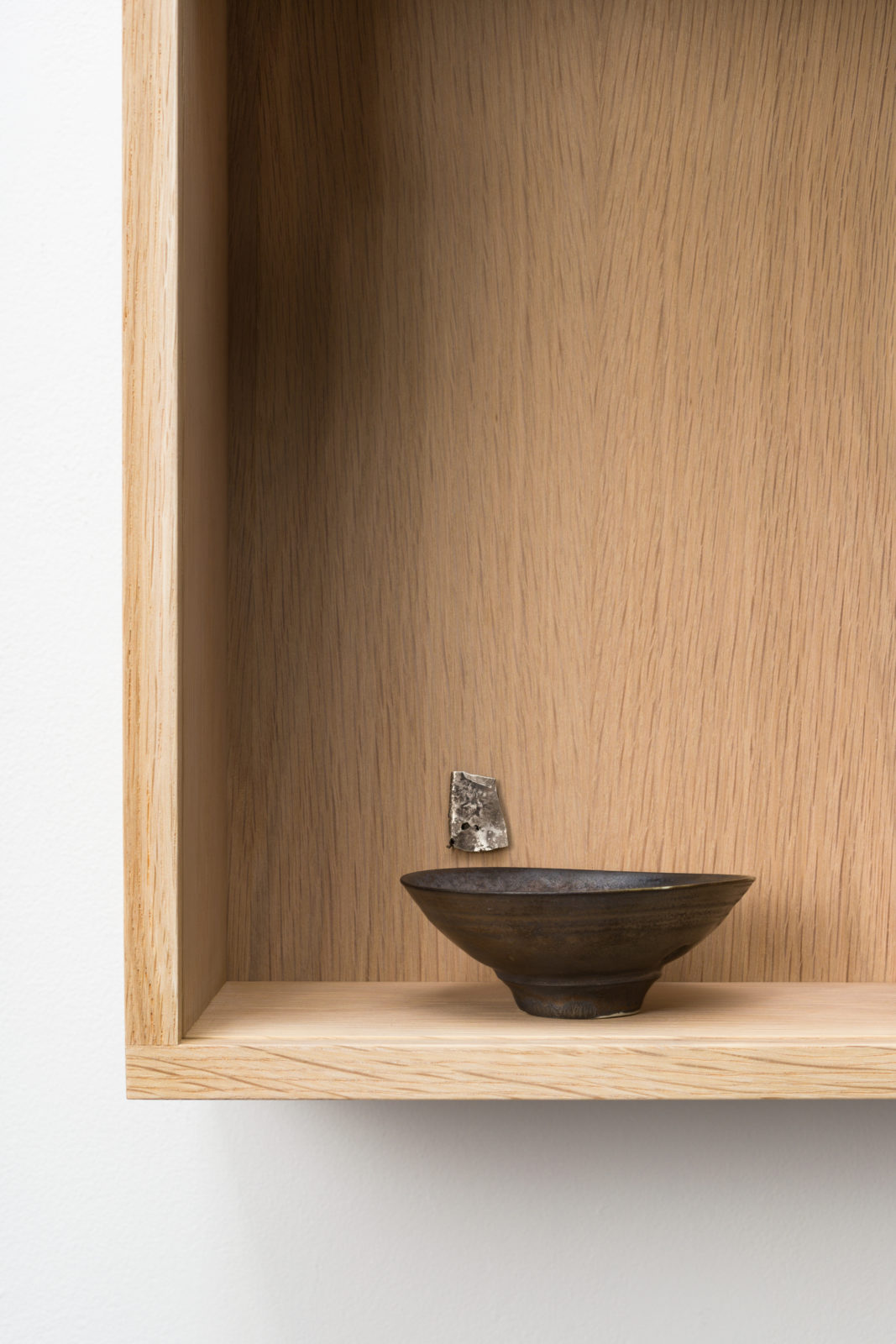
so much depends, VIII (detail)2024
Porcelain, silver, oak, and glass
37 × 30 × 15 cm
letters home
Galerie Max Hetzler, Berlin
14 June–10 August 2024
letters home is a solo exhibition of works by Edmund de Waal at Galerie Max Hetzler, Potsdamer Straße 77-87, Berlin. In addition to black, white and oak vitrines made this year, the exhibition includes both the largest free-standing clay vessels the artist has ever created, and a large-scale pavilion titled there are still songs to sing beyond mankind, 2024. Despite their differences in size and material, all the works are ultimately vessels whose interiors only seem to become more intimate as their dimensions increase.
Individual words or phrases from poems by Denise Riley (b. 1948), Paul Celan (1920–1970) and Rainer Maria Rilke (1875–1926) are interwoven in the titles or surfaces of these works by de Waal. Here, the focus is not on analysing the texts, but rather on their emotional heft. A further reference to language can be found in the forms of the vitrines, which seem reminiscent of pages from a book. The pavilion, also referred to as a kind of 'teahouse’ by de Waal, draws on the artist's memories of stays in Japan and his studies of sadō, the Japanese tea ceremony.
In dialogue not only with one another, but with history, literature and their surrounding space, de Waal’s works provide a place for pause, in his words, ‘letters home – my attempt to feel both the breath of separation and the pulse of connection’.
